
2024 Approved Repeated Text Animation Tutorial

Repeated Text Animation Tutorial
Preparation
What you need to prepare:
- A computer (Windows or macOS)
- Your video materials.
- Filmora video editor
Step 1
Download Filmora . Let it install and wait for it to run. Then, click on “New Project”. Now, you’re ready to edit!
Step 2
First, go to Titles and drag the Default Title to the Timeline.

Step 3
Now, double-click on the Default Title clip. Here, change its font to any bold font. Increase the text size to 120. Type in your text in the box. Scroll a bit down and change the Text Spacing to 8. Click OK.

Step 4
Take a Snapshot of this Default Title.

Step 5
Double-click on the Default Title clip once again. This time, click on its Advanced settings. Here, turn OFF Text Fill → turn ON Outline → change the Outline color to White → reduce Thickness to 1. Click OK. Now, take another Snapshot.

Step 6
Delete the Default Title clip from the Timeline. Now, drag the Outline snapshot that we just created to the Timeline. Open the Crop tool → change the Ratio to Custom → replace “1080” with “540”. Lastly, move the highlighted crop section to the top. Click OK.

Step 7
Double-click on the Snapshot to open its settings panel. Go to the Animation tab. Here, change the value of the Y-axis to “275”**.** Click OK. Now, take a Snapshot.

Step 8
Next, click on the Crop tool again and simply move the highlighted crop section to the bottom part of the screen. Click OK. Then, double-click on the snapshot clip in the Timeline and change the value of the Y-axis from “275” to “-275”**.** Click OK. Take a Snapshot again.
Step 9
Import a background image to My Media. Drag the background image to the Timeline. Double-click on it and drag the Scale bar until the background image covers the whole screen. Click OK. You should cut the background clip to make it 3 seconds long as well.

Step 10
Lock this track in the Timeline by pressing the highlighted button on the left. Then, go to “Track Manager” and add 6 new Tracks to the Timeline. Click OK.

Step 11
Drag the first Snapshot we made before to Track 6. Cut it so it’s 3 seconds long. Then, Lock the Track.

Step 12
Set the Playhead at the 15th frame on the Timeline. Then, drag the Upward Outline snapshot to this point. Double-click on it and change the Y-axis value to “**-4%**”. Then, reduce the Opacity to 0%. Now, move the Playhead 5 frames further. Next, increase the Opacity to 100% and increase the Y-axis value to around “105”. Don’t click OK yet.
Step 13
Move the Playhead to 1 minute and 5 seconds on the Timeline. Add a keyframe by clicking on the “+Add” button. Then, move the Playhead 5 frames forward. Here, change the Zoom Level to 25%.

Step 14
Double-click on the clip in Track 5. Drag the text like in the image below. Then, delete the part of the clip on the right side after 1 minute and 15 seconds.

Step 15
Hide the clips on Track 6 and Track 1 by clicking the “eye” icons next to them. Then, take a Snapshot. Now, drag this Snapshot right next to the clip on Track 5.
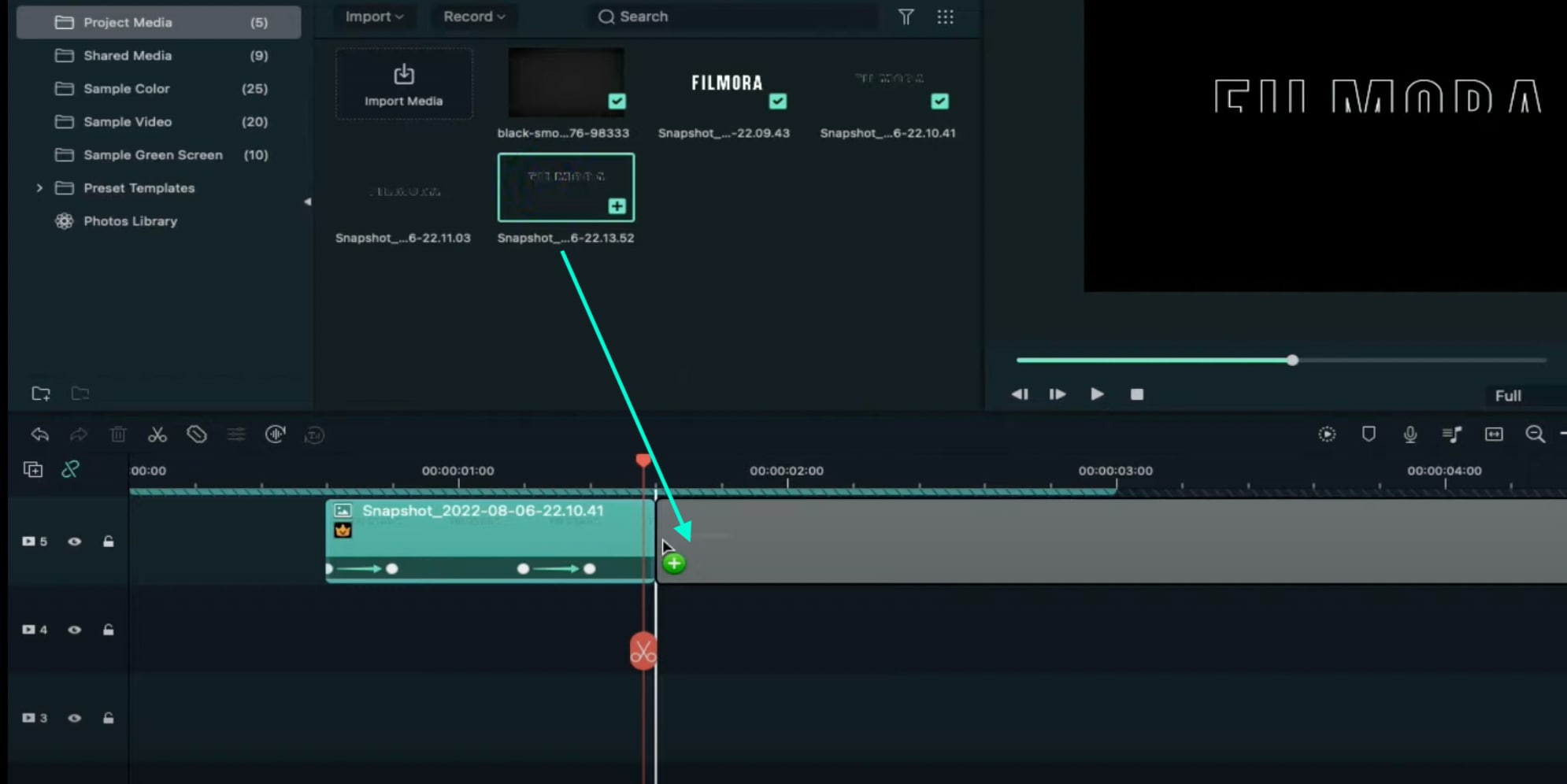
Step 16
Move the Playhead 3 frames forward from the starting point of the clip you just added. Unhide Track 6. Double-click on the clip on the right side of Track 5 and click on “+Add”. Move the Playhead 5 seconds forward and adjust the Upward Outline to fit the text.

Step 17
Move the Playhead 5 frames forward again. Drag the Y-axis value to the left until the outline clip overlaps the main text. Then, reduce the Opacity to 0%. Move the Playhead to 2 minutes and 10 seconds. Cut the Track and delete the clip on the right side. Lastly, Lock Track 5.
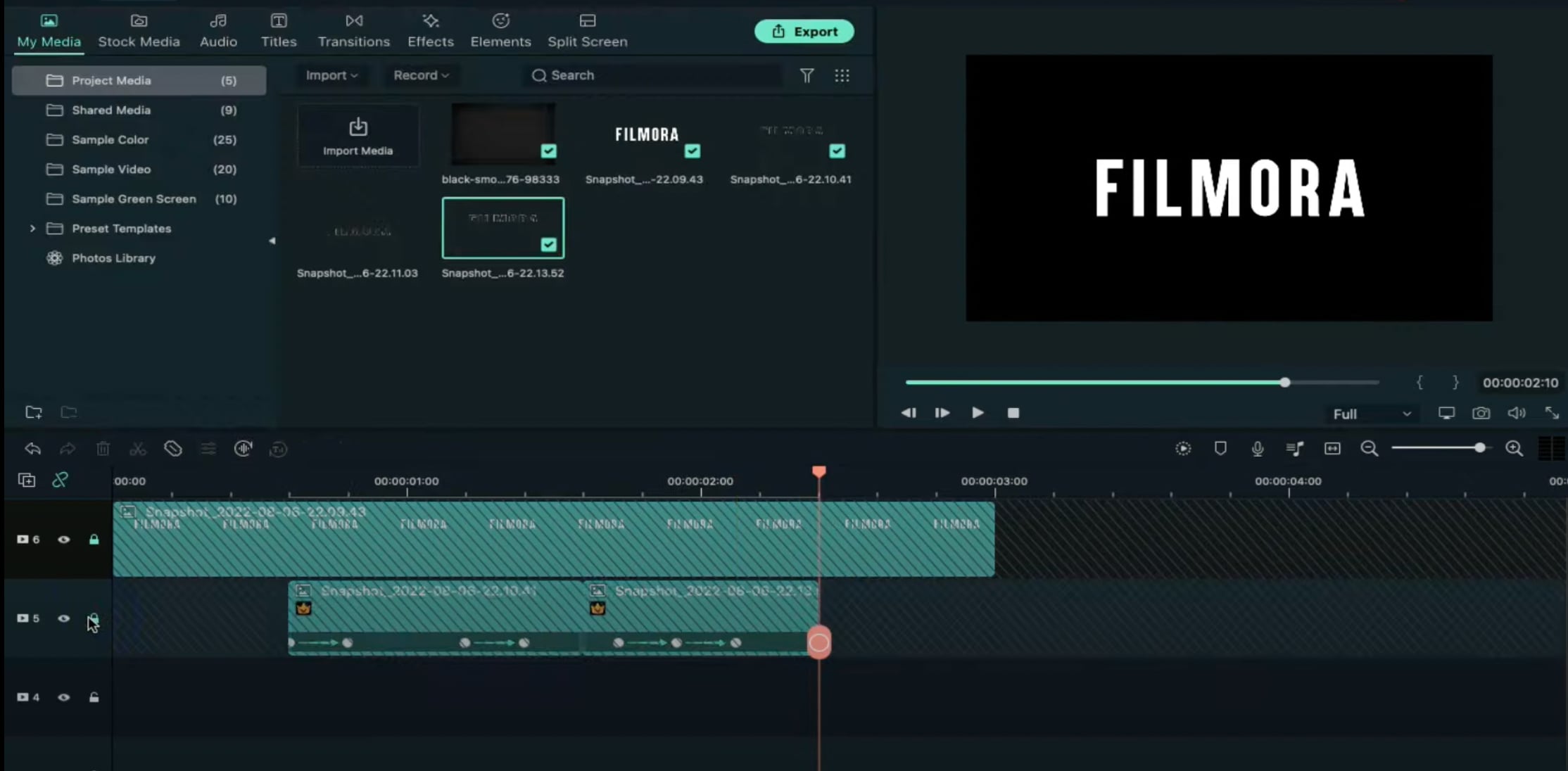
Step 18
Drag the Downward Outline snapshot to Track 4. Then, repeat the same process as in Step 16 and Step 17.
Step 19
Drag the Upward Outline snapshot to Track 3 at the 17th frame. Double-click on it and change the Opacity to 0%.
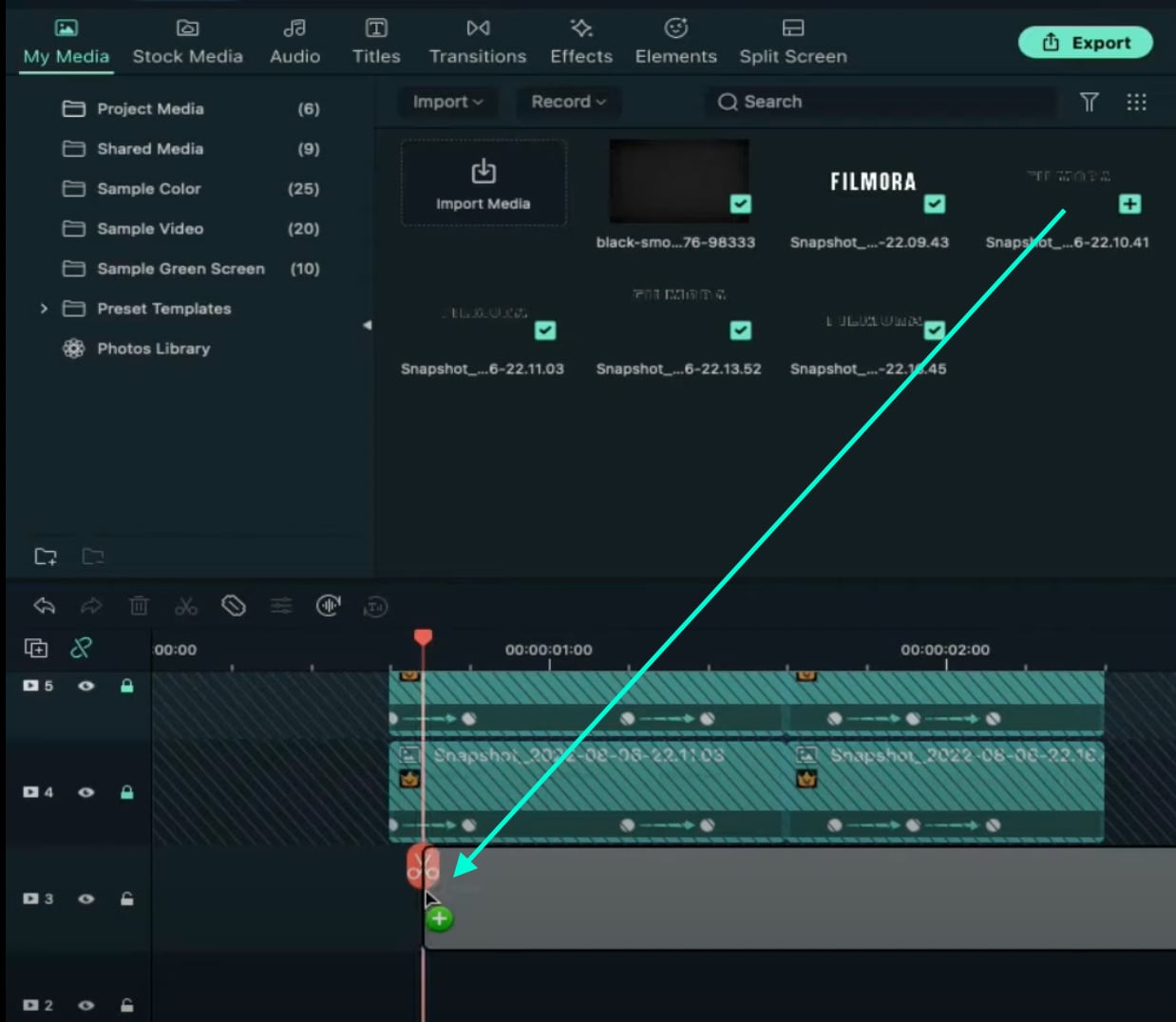
Step 20
Now, move 5 frames forward and increase the Opacity back to 100%. Then, drag the Y-axis value to the right until the screen looks like this.

Step 21
Move the Playhead to 1 minute and 5 seconds. Click on “+Add” to add a keyframe. Then, move the Playhead 5 frames forward. Double-click on the clip and stretch it from side to side to match something like this.

Step 22
Move the Playhead to 1 minute and 16 seconds. Split the clip and delete the part on the right side. Hide Track 4, 5, and 6. Then, take a Snapshot. Drag this Snapshot next to the clip on Track 3. Place the Playhead on 1 minute and 18 seconds. Then, unhide Track 4, 5, and 6.
Step 23
Double-click on the clip on the right side of Track 3. Add a keyframe by pressing “+Add”. Move the Playhead to 1 minute and 23 seconds. Now, resize the clip back to its original size by moving the rectangle left and right. Right now, it should look like this.

Step 24
Move the Playhead 5 frames forward. Drag the Y-axis value to the left until the screen looks like this.

Step 25
Move the Playhead 5 frames forward again. Drag the value of the Y-axis to the left until the screen looks like this. Then, change the Opacity to 0%. Finally, split the clip at 2 minutes and 10 seconds. Delete the part on the right side. Lock Track 3.
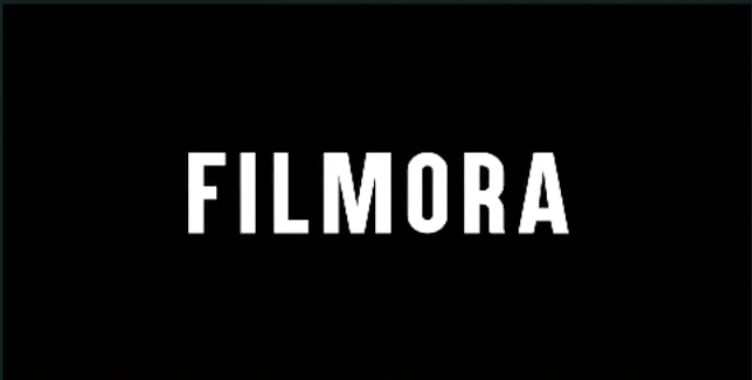
Step 26
Next, drag the Downward Snapshot on Track 2 and follow the same process as in Steps 19 through 25.
Step 27
Unhide the Background clip at the bottom of the Timeline. Then, Unlock Track 6. Split the clip on Track 6 at the 15th frame.

Step 28
Move the Playhead at the beginning of the Timeline. Click on the first part of the clip on Track 6. Add a keyframe. Drag the X-axis value to the right until the word disappears out of the screen. Like this. 👇Then, move the Playhead to the 6th frame and Reset the X-axis value to 0.0.

Step 29
Take the Playhead to 2 minutes and 10 seconds. Split it. Now, move the Playhead to 2 minutes and 19 seconds and add a keyframe. Lastly, take the Playhead to the very end of the clip and drag the text to the right side until it’s out of the screen once again.
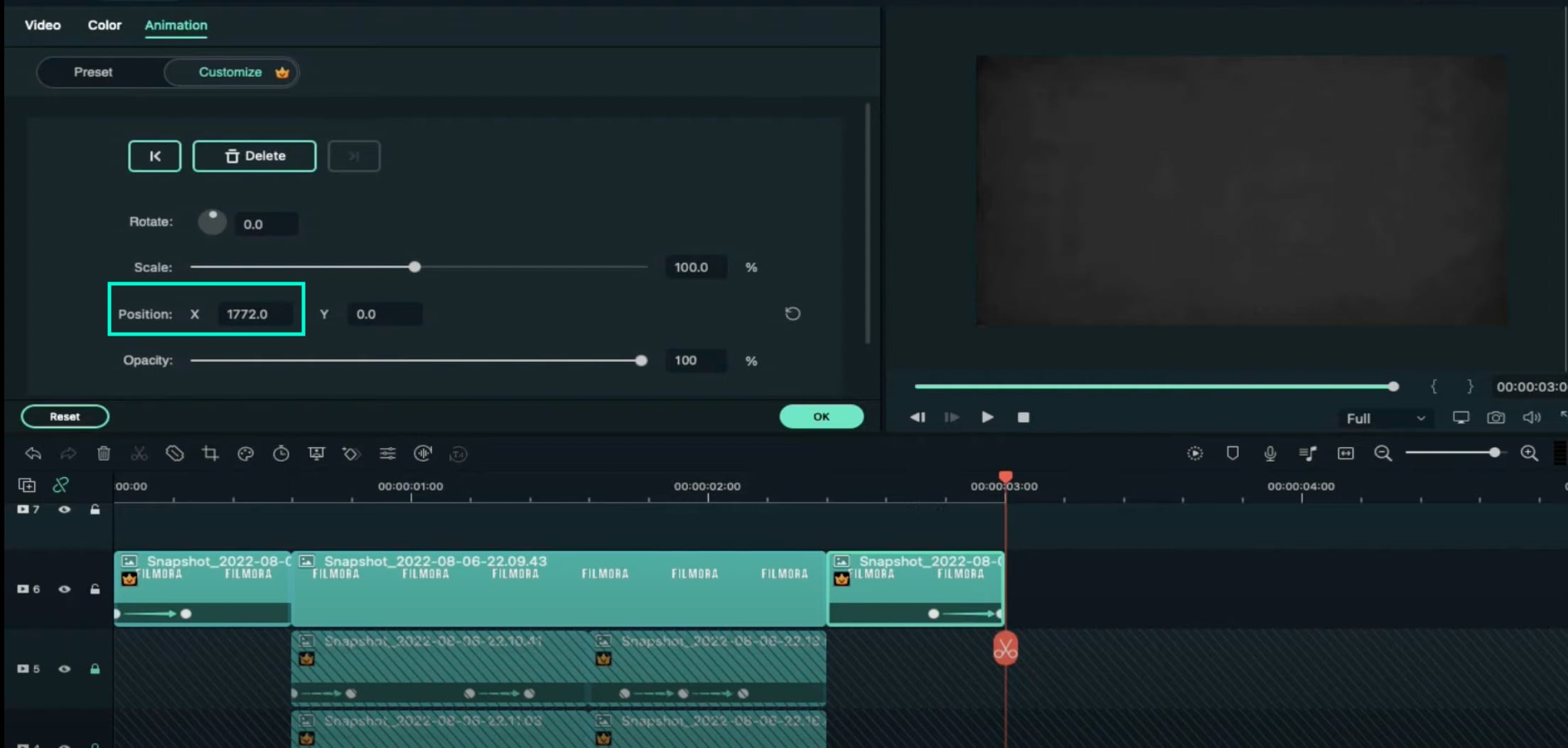
Step 30
Go to the Effects tab. Select Glitch from the panel on the left. Then, apply “Glitch Dispersion” and “Glitch Stripe 2” to the clips at the start and at the end.

Step 31
Finally, Render the video to watch the final preview. And, you’re done! Congratulations on creating a repeated text animation in Filmora.

Summary
What you’ve learned:
- How to create text animations in Filmora
- Applying animation effects
- Make advanced edits on Titles in Filmora
- Hide and lock Tracks and Clips in Filmora
What you need to prepare:
- A computer (Windows or macOS)
- Your video materials.
- Filmora video editor
Step 1
Download Filmora . Let it install and wait for it to run. Then, click on “New Project”. Now, you’re ready to edit!
Step 2
First, go to Titles and drag the Default Title to the Timeline.

Step 3
Now, double-click on the Default Title clip. Here, change its font to any bold font. Increase the text size to 120. Type in your text in the box. Scroll a bit down and change the Text Spacing to 8. Click OK.

Step 4
Take a Snapshot of this Default Title.

Step 5
Double-click on the Default Title clip once again. This time, click on its Advanced settings. Here, turn OFF Text Fill → turn ON Outline → change the Outline color to White → reduce Thickness to 1. Click OK. Now, take another Snapshot.

Step 6
Delete the Default Title clip from the Timeline. Now, drag the Outline snapshot that we just created to the Timeline. Open the Crop tool → change the Ratio to Custom → replace “1080” with “540”. Lastly, move the highlighted crop section to the top. Click OK.

Step 7
Double-click on the Snapshot to open its settings panel. Go to the Animation tab. Here, change the value of the Y-axis to “275”**.** Click OK. Now, take a Snapshot.

Step 8
Next, click on the Crop tool again and simply move the highlighted crop section to the bottom part of the screen. Click OK. Then, double-click on the snapshot clip in the Timeline and change the value of the Y-axis from “275” to “-275”**.** Click OK. Take a Snapshot again.
Step 9
Import a background image to My Media. Drag the background image to the Timeline. Double-click on it and drag the Scale bar until the background image covers the whole screen. Click OK. You should cut the background clip to make it 3 seconds long as well.

Step 10
Lock this track in the Timeline by pressing the highlighted button on the left. Then, go to “Track Manager” and add 6 new Tracks to the Timeline. Click OK.

Step 11
Drag the first Snapshot we made before to Track 6. Cut it so it’s 3 seconds long. Then, Lock the Track.

Step 12
Set the Playhead at the 15th frame on the Timeline. Then, drag the Upward Outline snapshot to this point. Double-click on it and change the Y-axis value to “**-4%**”. Then, reduce the Opacity to 0%. Now, move the Playhead 5 frames further. Next, increase the Opacity to 100% and increase the Y-axis value to around “105”. Don’t click OK yet.
Step 13
Move the Playhead to 1 minute and 5 seconds on the Timeline. Add a keyframe by clicking on the “+Add” button. Then, move the Playhead 5 frames forward. Here, change the Zoom Level to 25%.

Step 14
Double-click on the clip in Track 5. Drag the text like in the image below. Then, delete the part of the clip on the right side after 1 minute and 15 seconds.

Step 15
Hide the clips on Track 6 and Track 1 by clicking the “eye” icons next to them. Then, take a Snapshot. Now, drag this Snapshot right next to the clip on Track 5.

Step 16
Move the Playhead 3 frames forward from the starting point of the clip you just added. Unhide Track 6. Double-click on the clip on the right side of Track 5 and click on “+Add”. Move the Playhead 5 seconds forward and adjust the Upward Outline to fit the text.

Step 17
Move the Playhead 5 frames forward again. Drag the Y-axis value to the left until the outline clip overlaps the main text. Then, reduce the Opacity to 0%. Move the Playhead to 2 minutes and 10 seconds. Cut the Track and delete the clip on the right side. Lastly, Lock Track 5.

Step 18
Drag the Downward Outline snapshot to Track 4. Then, repeat the same process as in Step 16 and Step 17.
Step 19
Drag the Upward Outline snapshot to Track 3 at the 17th frame. Double-click on it and change the Opacity to 0%.

Step 20
Now, move 5 frames forward and increase the Opacity back to 100%. Then, drag the Y-axis value to the right until the screen looks like this.

Step 21
Move the Playhead to 1 minute and 5 seconds. Click on “+Add” to add a keyframe. Then, move the Playhead 5 frames forward. Double-click on the clip and stretch it from side to side to match something like this.

Step 22
Move the Playhead to 1 minute and 16 seconds. Split the clip and delete the part on the right side. Hide Track 4, 5, and 6. Then, take a Snapshot. Drag this Snapshot next to the clip on Track 3. Place the Playhead on 1 minute and 18 seconds. Then, unhide Track 4, 5, and 6.
Step 23
Double-click on the clip on the right side of Track 3. Add a keyframe by pressing “+Add”. Move the Playhead to 1 minute and 23 seconds. Now, resize the clip back to its original size by moving the rectangle left and right. Right now, it should look like this.

Step 24
Move the Playhead 5 frames forward. Drag the Y-axis value to the left until the screen looks like this.

Step 25
Move the Playhead 5 frames forward again. Drag the value of the Y-axis to the left until the screen looks like this. Then, change the Opacity to 0%. Finally, split the clip at 2 minutes and 10 seconds. Delete the part on the right side. Lock Track 3.

Step 26
Next, drag the Downward Snapshot on Track 2 and follow the same process as in Steps 19 through 25.
Step 27
Unhide the Background clip at the bottom of the Timeline. Then, Unlock Track 6. Split the clip on Track 6 at the 15th frame.

Step 28
Move the Playhead at the beginning of the Timeline. Click on the first part of the clip on Track 6. Add a keyframe. Drag the X-axis value to the right until the word disappears out of the screen. Like this. 👇Then, move the Playhead to the 6th frame and Reset the X-axis value to 0.0.

Step 29
Take the Playhead to 2 minutes and 10 seconds. Split it. Now, move the Playhead to 2 minutes and 19 seconds and add a keyframe. Lastly, take the Playhead to the very end of the clip and drag the text to the right side until it’s out of the screen once again.

Step 30
Go to the Effects tab. Select Glitch from the panel on the left. Then, apply “Glitch Dispersion” and “Glitch Stripe 2” to the clips at the start and at the end.

Step 31
Finally, Render the video to watch the final preview. And, you’re done! Congratulations on creating a repeated text animation in Filmora.

Summary
What you’ve learned:
- How to create text animations in Filmora
- Applying animation effects
- Make advanced edits on Titles in Filmora
- Hide and lock Tracks and Clips in Filmora
What you need to prepare:
- A computer (Windows or macOS)
- Your video materials.
- Filmora video editor
Step 1
Download Filmora . Let it install and wait for it to run. Then, click on “New Project”. Now, you’re ready to edit!
Step 2
First, go to Titles and drag the Default Title to the Timeline.

Step 3
Now, double-click on the Default Title clip. Here, change its font to any bold font. Increase the text size to 120. Type in your text in the box. Scroll a bit down and change the Text Spacing to 8. Click OK.

Step 4
Take a Snapshot of this Default Title.

Step 5
Double-click on the Default Title clip once again. This time, click on its Advanced settings. Here, turn OFF Text Fill → turn ON Outline → change the Outline color to White → reduce Thickness to 1. Click OK. Now, take another Snapshot.

Step 6
Delete the Default Title clip from the Timeline. Now, drag the Outline snapshot that we just created to the Timeline. Open the Crop tool → change the Ratio to Custom → replace “1080” with “540”. Lastly, move the highlighted crop section to the top. Click OK.

Step 7
Double-click on the Snapshot to open its settings panel. Go to the Animation tab. Here, change the value of the Y-axis to “275”**.** Click OK. Now, take a Snapshot.

Step 8
Next, click on the Crop tool again and simply move the highlighted crop section to the bottom part of the screen. Click OK. Then, double-click on the snapshot clip in the Timeline and change the value of the Y-axis from “275” to “-275”**.** Click OK. Take a Snapshot again.
Step 9
Import a background image to My Media. Drag the background image to the Timeline. Double-click on it and drag the Scale bar until the background image covers the whole screen. Click OK. You should cut the background clip to make it 3 seconds long as well.

Step 10
Lock this track in the Timeline by pressing the highlighted button on the left. Then, go to “Track Manager” and add 6 new Tracks to the Timeline. Click OK.

Step 11
Drag the first Snapshot we made before to Track 6. Cut it so it’s 3 seconds long. Then, Lock the Track.

Step 12
Set the Playhead at the 15th frame on the Timeline. Then, drag the Upward Outline snapshot to this point. Double-click on it and change the Y-axis value to “**-4%**”. Then, reduce the Opacity to 0%. Now, move the Playhead 5 frames further. Next, increase the Opacity to 100% and increase the Y-axis value to around “105”. Don’t click OK yet.
Step 13
Move the Playhead to 1 minute and 5 seconds on the Timeline. Add a keyframe by clicking on the “+Add” button. Then, move the Playhead 5 frames forward. Here, change the Zoom Level to 25%.

Step 14
Double-click on the clip in Track 5. Drag the text like in the image below. Then, delete the part of the clip on the right side after 1 minute and 15 seconds.

Step 15
Hide the clips on Track 6 and Track 1 by clicking the “eye” icons next to them. Then, take a Snapshot. Now, drag this Snapshot right next to the clip on Track 5.

Step 16
Move the Playhead 3 frames forward from the starting point of the clip you just added. Unhide Track 6. Double-click on the clip on the right side of Track 5 and click on “+Add”. Move the Playhead 5 seconds forward and adjust the Upward Outline to fit the text.

Step 17
Move the Playhead 5 frames forward again. Drag the Y-axis value to the left until the outline clip overlaps the main text. Then, reduce the Opacity to 0%. Move the Playhead to 2 minutes and 10 seconds. Cut the Track and delete the clip on the right side. Lastly, Lock Track 5.

Step 18
Drag the Downward Outline snapshot to Track 4. Then, repeat the same process as in Step 16 and Step 17.
Step 19
Drag the Upward Outline snapshot to Track 3 at the 17th frame. Double-click on it and change the Opacity to 0%.

Step 20
Now, move 5 frames forward and increase the Opacity back to 100%. Then, drag the Y-axis value to the right until the screen looks like this.

Step 21
Move the Playhead to 1 minute and 5 seconds. Click on “+Add” to add a keyframe. Then, move the Playhead 5 frames forward. Double-click on the clip and stretch it from side to side to match something like this.

Step 22
Move the Playhead to 1 minute and 16 seconds. Split the clip and delete the part on the right side. Hide Track 4, 5, and 6. Then, take a Snapshot. Drag this Snapshot next to the clip on Track 3. Place the Playhead on 1 minute and 18 seconds. Then, unhide Track 4, 5, and 6.
Step 23
Double-click on the clip on the right side of Track 3. Add a keyframe by pressing “+Add”. Move the Playhead to 1 minute and 23 seconds. Now, resize the clip back to its original size by moving the rectangle left and right. Right now, it should look like this.

Step 24
Move the Playhead 5 frames forward. Drag the Y-axis value to the left until the screen looks like this.

Step 25
Move the Playhead 5 frames forward again. Drag the value of the Y-axis to the left until the screen looks like this. Then, change the Opacity to 0%. Finally, split the clip at 2 minutes and 10 seconds. Delete the part on the right side. Lock Track 3.

Step 26
Next, drag the Downward Snapshot on Track 2 and follow the same process as in Steps 19 through 25.
Step 27
Unhide the Background clip at the bottom of the Timeline. Then, Unlock Track 6. Split the clip on Track 6 at the 15th frame.

Step 28
Move the Playhead at the beginning of the Timeline. Click on the first part of the clip on Track 6. Add a keyframe. Drag the X-axis value to the right until the word disappears out of the screen. Like this. 👇Then, move the Playhead to the 6th frame and Reset the X-axis value to 0.0.

Step 29
Take the Playhead to 2 minutes and 10 seconds. Split it. Now, move the Playhead to 2 minutes and 19 seconds and add a keyframe. Lastly, take the Playhead to the very end of the clip and drag the text to the right side until it’s out of the screen once again.

Step 30
Go to the Effects tab. Select Glitch from the panel on the left. Then, apply “Glitch Dispersion” and “Glitch Stripe 2” to the clips at the start and at the end.

Step 31
Finally, Render the video to watch the final preview. And, you’re done! Congratulations on creating a repeated text animation in Filmora.

Summary
What you’ve learned:
- How to create text animations in Filmora
- Applying animation effects
- Make advanced edits on Titles in Filmora
- Hide and lock Tracks and Clips in Filmora
What you need to prepare:
- A computer (Windows or macOS)
- Your video materials.
- Filmora video editor
Step 1
Download Filmora . Let it install and wait for it to run. Then, click on “New Project”. Now, you’re ready to edit!
Step 2
First, go to Titles and drag the Default Title to the Timeline.

Step 3
Now, double-click on the Default Title clip. Here, change its font to any bold font. Increase the text size to 120. Type in your text in the box. Scroll a bit down and change the Text Spacing to 8. Click OK.

Step 4
Take a Snapshot of this Default Title.

Step 5
Double-click on the Default Title clip once again. This time, click on its Advanced settings. Here, turn OFF Text Fill → turn ON Outline → change the Outline color to White → reduce Thickness to 1. Click OK. Now, take another Snapshot.

Step 6
Delete the Default Title clip from the Timeline. Now, drag the Outline snapshot that we just created to the Timeline. Open the Crop tool → change the Ratio to Custom → replace “1080” with “540”. Lastly, move the highlighted crop section to the top. Click OK.

Step 7
Double-click on the Snapshot to open its settings panel. Go to the Animation tab. Here, change the value of the Y-axis to “275”**.** Click OK. Now, take a Snapshot.

Step 8
Next, click on the Crop tool again and simply move the highlighted crop section to the bottom part of the screen. Click OK. Then, double-click on the snapshot clip in the Timeline and change the value of the Y-axis from “275” to “-275”**.** Click OK. Take a Snapshot again.
Step 9
Import a background image to My Media. Drag the background image to the Timeline. Double-click on it and drag the Scale bar until the background image covers the whole screen. Click OK. You should cut the background clip to make it 3 seconds long as well.

Step 10
Lock this track in the Timeline by pressing the highlighted button on the left. Then, go to “Track Manager” and add 6 new Tracks to the Timeline. Click OK.

Step 11
Drag the first Snapshot we made before to Track 6. Cut it so it’s 3 seconds long. Then, Lock the Track.

Step 12
Set the Playhead at the 15th frame on the Timeline. Then, drag the Upward Outline snapshot to this point. Double-click on it and change the Y-axis value to “**-4%**”. Then, reduce the Opacity to 0%. Now, move the Playhead 5 frames further. Next, increase the Opacity to 100% and increase the Y-axis value to around “105”. Don’t click OK yet.
Step 13
Move the Playhead to 1 minute and 5 seconds on the Timeline. Add a keyframe by clicking on the “+Add” button. Then, move the Playhead 5 frames forward. Here, change the Zoom Level to 25%.

Step 14
Double-click on the clip in Track 5. Drag the text like in the image below. Then, delete the part of the clip on the right side after 1 minute and 15 seconds.

Step 15
Hide the clips on Track 6 and Track 1 by clicking the “eye” icons next to them. Then, take a Snapshot. Now, drag this Snapshot right next to the clip on Track 5.

Step 16
Move the Playhead 3 frames forward from the starting point of the clip you just added. Unhide Track 6. Double-click on the clip on the right side of Track 5 and click on “+Add”. Move the Playhead 5 seconds forward and adjust the Upward Outline to fit the text.

Step 17
Move the Playhead 5 frames forward again. Drag the Y-axis value to the left until the outline clip overlaps the main text. Then, reduce the Opacity to 0%. Move the Playhead to 2 minutes and 10 seconds. Cut the Track and delete the clip on the right side. Lastly, Lock Track 5.

Step 18
Drag the Downward Outline snapshot to Track 4. Then, repeat the same process as in Step 16 and Step 17.
Step 19
Drag the Upward Outline snapshot to Track 3 at the 17th frame. Double-click on it and change the Opacity to 0%.

Step 20
Now, move 5 frames forward and increase the Opacity back to 100%. Then, drag the Y-axis value to the right until the screen looks like this.

Step 21
Move the Playhead to 1 minute and 5 seconds. Click on “+Add” to add a keyframe. Then, move the Playhead 5 frames forward. Double-click on the clip and stretch it from side to side to match something like this.

Step 22
Move the Playhead to 1 minute and 16 seconds. Split the clip and delete the part on the right side. Hide Track 4, 5, and 6. Then, take a Snapshot. Drag this Snapshot next to the clip on Track 3. Place the Playhead on 1 minute and 18 seconds. Then, unhide Track 4, 5, and 6.
Step 23
Double-click on the clip on the right side of Track 3. Add a keyframe by pressing “+Add”. Move the Playhead to 1 minute and 23 seconds. Now, resize the clip back to its original size by moving the rectangle left and right. Right now, it should look like this.

Step 24
Move the Playhead 5 frames forward. Drag the Y-axis value to the left until the screen looks like this.

Step 25
Move the Playhead 5 frames forward again. Drag the value of the Y-axis to the left until the screen looks like this. Then, change the Opacity to 0%. Finally, split the clip at 2 minutes and 10 seconds. Delete the part on the right side. Lock Track 3.

Step 26
Next, drag the Downward Snapshot on Track 2 and follow the same process as in Steps 19 through 25.
Step 27
Unhide the Background clip at the bottom of the Timeline. Then, Unlock Track 6. Split the clip on Track 6 at the 15th frame.

Step 28
Move the Playhead at the beginning of the Timeline. Click on the first part of the clip on Track 6. Add a keyframe. Drag the X-axis value to the right until the word disappears out of the screen. Like this. 👇Then, move the Playhead to the 6th frame and Reset the X-axis value to 0.0.

Step 29
Take the Playhead to 2 minutes and 10 seconds. Split it. Now, move the Playhead to 2 minutes and 19 seconds and add a keyframe. Lastly, take the Playhead to the very end of the clip and drag the text to the right side until it’s out of the screen once again.

Step 30
Go to the Effects tab. Select Glitch from the panel on the left. Then, apply “Glitch Dispersion” and “Glitch Stripe 2” to the clips at the start and at the end.

Step 31
Finally, Render the video to watch the final preview. And, you’re done! Congratulations on creating a repeated text animation in Filmora.

Summary
What you’ve learned:
- How to create text animations in Filmora
- Applying animation effects
- Make advanced edits on Titles in Filmora
- Hide and lock Tracks and Clips in Filmora
How to Create a Slideshow on iPhone
How to Make a Slideshow on iPhone
An easy yet powerful editor
Numerous effects to choose from
Detailed tutorials provided by the official channel
Slideshows are acceptable ways to easily sum up your amazing trip or excellent events instead of showing-off whole bunch of photos to all your surroundings. You can easily pick up beautiful moments in order to put them all together to easily create some beautiful videos.
For making a slideshow on iPhone, you can add a slice of music, effects and other ingredients to make it looks amazing. The Photo Slideshow iPhone Maker is a kind of app that can easily create beautiful music videos from you existing pictures and this also comes with amazing qualities to enhance your appearance on the go. With a rich music library and amazing effects, you can differently apply background music to your slideshow or video. With just a drag & drop facility and some tools to define your slideshow making, it is an easy process to consider.
In this article
01 [How to Make a Slideshow on iPhone](#Part 1)
02 [How to Save Slideshow on iPhone](#Part 2)
03 [How to Share Slideshow on iPhone](#Part 3)
04 [How to Send a Slideshow on iPhone](#Part 4)
05 [8 Free Slideshow Maker for iPhone](#Part 5)
Part 1 How to Make a Slideshow on iPhone
The iPhone is one of the most amazing devices that are capable of doing so many things, like making a picture slideshow or quickly adding pictures to turn up the normal pictures into life-long memories, you can do a lot of things. In case you are looking for a way to make a slideshow quickly then Photos app in iPhone can help you a lot. On the other hand, if you need something else, you can take help of other apps on the market once after downloading any one of your choice.
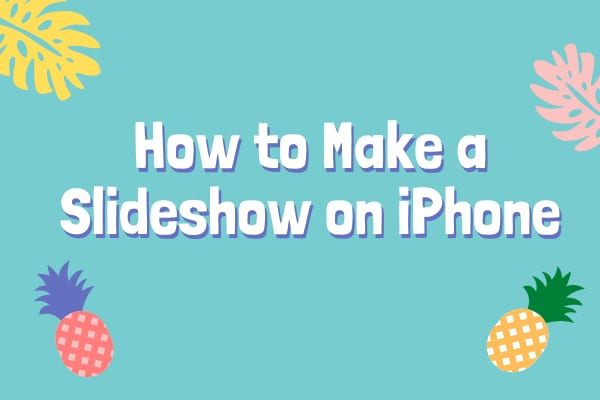
Here, we are talking about making slideshow on iPhone to collect tons of memories and later on sharing it with your friends of family members. Right from adding music, converting the transitions or quickly polishing any existing video, here is how you can easily make a Slideshow on iPhone with Photos app:
● Open Photos app & then select desired album that you want to use in your slideshow.
● Tap on pictures you need to start making a slideshow.
● After selecting a starting picture, tap on Share-button on the bottom left.
● Scroll down, and choose Slideshow.
● Your slideshow will automatically starts playing.
● In order to further edit the settings of your slideshow, tap on the screen & then tap pause icon at bottom centre of your screen
● Tap Options to refine your steps of how to create a slideshow on iPhone.
● Then edit Theme, Music, and choose speed of the slideshow.
● After making desirable changes, tap done and enjoy playing it.
● If you want to share the slideshow created, tap on the pause button again & then select AirPlay-icon in upper-right corner of your screen.
● Tap on the name of your device you would like to Air Play the slideshow to.
● Once you are done with playing a slideshow, tap done in upper-left corner in order to end your slideshow.
Your device can save these settings automatically if you want to your album as the slideshow. For more glory, you can add filters in a polished manner to finish the steps to create slide show on iPhone.
Part 2 How to Save Slideshow on iPhone
Once after creating the slideshow with your iPhone device, if you want to know how to save a slideshow on iPhone then you need to be little tricky because there is no way to save the slideshow created by directly using the Photos App. You can instead make use of iPhone screen recording feature to save it when your slideshow plays. You can later on trim the desired video with perfect start & end. With the photos app, you can only save your memories as a slideshow and it is just like a curated collection of pictures with ‘Year in review’.

Here is the complete assistance on how to save slideshow on iPhone:-
● Tap done on the top-left corner with your project
● Tap Share icon.
● Select the Save Video option.
● The iMovie will easily export as well as save desired slideshow in Photos app.
Part 3 How to Share Slideshow on iPhone
In order to create as well as share the desired slideshow of your photos in the Apple’s Photos app, you just need to choose shots from the device and add some special themes with the selected fonts & background music and at last share final product with your friends. The photos app of your iPhone mainly offers slightly two different kinds of slideshows with regular one allowing you to easily change theme, duration of the music added to a certain number of choices but on the other hand memory movie can allow you to modify the theme to tweak music, font, length and music at no worries.

This is how you can share a slideshow on iPhone:
If you want to know how to share slideshow on iPhone, tap share icon at the corner, and then use share screen feature to choose the desired destination like Messages, OneDrive, YouTube, Mail, Facebook, and others. The Photos application will then automatically export the desired movie to the services like: Facebook.
At last your app will preview its slideshow & then lets you easily include text, location, tag people, etc. Now, you are finished with the process to share the slideshow, tap on the share & explore your slideshow easily.
Part 4 How to Send a Slideshow on iPhone
If you are curious to know more about the process to send a slideshow on iPhone device then it is the not so difficult. With some consistency in your slideshow you can export your video to share with your loved ones in a smooth manner. Besides various transitions & effects, one can easily add stickers, text, before sending the video with share option. If you want to send the completed slideshow then quickly tap on the share icon and then choose any destination like Messages, OneDrive, YouTube, Mail, Facebook, etc. this will automatically export deliver the slideshow to your friends.

Part 5 Free Slideshow Maker for iPhone
On next we are heading towards the process to find out few amazing free slideshow makers for an iPhone. There are multiple apps are present in the market, out of which you can choose the one as per your need and comfort. So let’s begin with the discussion of each & every app, one by one:
01Vimory
The highlighted features of Vimory
● A unique Slideshow Maker
● Video-Editor
● Photo-Editor
● Giving you a feature to directly export the slideshow to Social Media
● Output at 4k
● Animated slideshow making
● Some incredible effects
● Superfast image editor
● Comes with stylish text and transitions
The Vimory offers you multiple ways to make some beautiful videos through the pictures one can easily add music track right from the app. It is the fantastic app for creating a slideshow on iPhone with significant effects, pretty amazing frames, fashionable filters and compelling music.
02PicPlayPost
The highlighted features of PicPlayPost
● Ability to Createalmost 30-minute slideshows.
● Built-in live video wallpapers.
● Record the slideshow video in HD with 1080P & 4K HD option.
● Trim, slow-down, speed up the videos
● Full featured editing capabilities
Entirely known for an ability to import the photos, add multiple texts, stickers, slide transition, &choose some amazing background music. This comes with an option to share your creations to your device gallery, Gmail, Facebook, YouTube, Messenger, Twitter, WhatsApp, Google Photos, and many more.
03Slide Lab
Highlighted features of Slidelab
● A complete Slideshow Editor
● Easy to import Option
● Music Tracks
● Comes with many video Tracks
● Audio Editing
One of the most amazing apps to turn your pictures into a realistic slideshow containing music, an extensive collection of multiple transitions to avoid sudden-jumps, in-app music library and an option to choose the in-app purchase in order to remove watermark.
04iMovie
Some of the most amazing features of iMovie:
● Ability to customize the movie studio logos, credits and cast names.
● Adjust the titles by changing the font, colour, location and size.
● Enhancing your movie by slowing-down or speeding-up desired clip.
● Easily add picture inside the picture, green-screen,& a split-screen effect.
One of the finest Photo slideshow maker through iPhone, iMovie is the fantastic slideshow maker. As compared to various other apps on the market this comes with useful features to make the slideshow simplistic yet attractive. Its frills-free interface can easily charms-up your slideshow making experience.
05Viva Video
The highlighted features of Viva Video
● Great varieties of Video Editing Tools
● Amazing Trendy Frames
● Aesthetics-Filters
● Edit any Music
● Sticker &typing option.
● Straightforward and easy to understand
● Wide range of audio tracks, effects and themes
This app is mix of free and a paid subscription and with the later one you can add some amazing effects and themes with professional editing features.
06Movavi Clips Easy Video Editor
The highlighted features of Movavi
● Edit any footage on a handy timeline
● Intuitive interface
● Movie maker without any ads
● Quick & precise
● Ability to trim and cut audios
This app is available for both iOS &Android users. If you want to know how to make a slideshow on iPhone with this app then interestingly it is very easy for you to do that.Movavi can deliver you amazing video editing experience and usually comes with some fine quality of effects and themes.
07Magisto Video Editor and Maker
The highlighted features of Magisto
● Easily create a moving photo slideshow or a video collage
● Ready-made templates
● Video Editing features like: cut, merge, trim, or reorder.
● Customization options available with editing of text, fonts, orientation, colors etc.
08MoShow Slideshow Photo & Video
● Easily Adjust Slideshow-timing
● Access few exclusive video-templates.
● Create GIFs as well as looping videos.
● Fine collection of templates
● Built-in music-options
Wondershare Filmora Video Editor can be used for making high quality videos and editing them. The styling, custom options and ease of adding effects in the video make this app popular. The application is well equipped with a wide variety of slideshow making tools.
For Win 7 or later (64-bit)
For macOS 10.12 or later
Key features
● Audio mixing feature
● Tilt shift
● Multiple video clips layer facility
● Adding and editing text feature
● Preview frame wise
● Video stabilizer
In terms of true quality of artificial intelligence technology, this app is the finest one on the list of all the apps for making an iPhone slideshow. If you are curious about the process to create slideshow on iPhone thenfinally you are getting rich collection of features in it like: stabilization, object-detection option, stylish effects, filters, and many more to outshine any average looking slideshow or a video collage.You can easily make collage or a short movie with Magisto video editor with great combination of special effects, graphics and filters.
● Ending Thoughts →
● Make use of some user friendly or light apps to create a slideshow of small sizes
● You can move further onto heavy duty apps for making long videos
● Some apps are having a possible number of features to offer you affordable options
● However, other promising apps like Filmora can give you amazing options to create some logical slideshows for any occasion and at no hidden cost. You can make use of Filmora to adding plenty of designing features to your video.
Slideshows are acceptable ways to easily sum up your amazing trip or excellent events instead of showing-off whole bunch of photos to all your surroundings. You can easily pick up beautiful moments in order to put them all together to easily create some beautiful videos.
For making a slideshow on iPhone, you can add a slice of music, effects and other ingredients to make it looks amazing. The Photo Slideshow iPhone Maker is a kind of app that can easily create beautiful music videos from you existing pictures and this also comes with amazing qualities to enhance your appearance on the go. With a rich music library and amazing effects, you can differently apply background music to your slideshow or video. With just a drag & drop facility and some tools to define your slideshow making, it is an easy process to consider.
In this article
01 [How to Make a Slideshow on iPhone](#Part 1)
02 [How to Save Slideshow on iPhone](#Part 2)
03 [How to Share Slideshow on iPhone](#Part 3)
04 [How to Send a Slideshow on iPhone](#Part 4)
05 [8 Free Slideshow Maker for iPhone](#Part 5)
Part 1 How to Make a Slideshow on iPhone
The iPhone is one of the most amazing devices that are capable of doing so many things, like making a picture slideshow or quickly adding pictures to turn up the normal pictures into life-long memories, you can do a lot of things. In case you are looking for a way to make a slideshow quickly then Photos app in iPhone can help you a lot. On the other hand, if you need something else, you can take help of other apps on the market once after downloading any one of your choice.

Here, we are talking about making slideshow on iPhone to collect tons of memories and later on sharing it with your friends of family members. Right from adding music, converting the transitions or quickly polishing any existing video, here is how you can easily make a Slideshow on iPhone with Photos app:
● Open Photos app & then select desired album that you want to use in your slideshow.
● Tap on pictures you need to start making a slideshow.
● After selecting a starting picture, tap on Share-button on the bottom left.
● Scroll down, and choose Slideshow.
● Your slideshow will automatically starts playing.
● In order to further edit the settings of your slideshow, tap on the screen & then tap pause icon at bottom centre of your screen
● Tap Options to refine your steps of how to create a slideshow on iPhone.
● Then edit Theme, Music, and choose speed of the slideshow.
● After making desirable changes, tap done and enjoy playing it.
● If you want to share the slideshow created, tap on the pause button again & then select AirPlay-icon in upper-right corner of your screen.
● Tap on the name of your device you would like to Air Play the slideshow to.
● Once you are done with playing a slideshow, tap done in upper-left corner in order to end your slideshow.
Your device can save these settings automatically if you want to your album as the slideshow. For more glory, you can add filters in a polished manner to finish the steps to create slide show on iPhone.
Part 2 How to Save Slideshow on iPhone
Once after creating the slideshow with your iPhone device, if you want to know how to save a slideshow on iPhone then you need to be little tricky because there is no way to save the slideshow created by directly using the Photos App. You can instead make use of iPhone screen recording feature to save it when your slideshow plays. You can later on trim the desired video with perfect start & end. With the photos app, you can only save your memories as a slideshow and it is just like a curated collection of pictures with ‘Year in review’.

Here is the complete assistance on how to save slideshow on iPhone:-
● Tap done on the top-left corner with your project
● Tap Share icon.
● Select the Save Video option.
● The iMovie will easily export as well as save desired slideshow in Photos app.
Part 3 How to Share Slideshow on iPhone
In order to create as well as share the desired slideshow of your photos in the Apple’s Photos app, you just need to choose shots from the device and add some special themes with the selected fonts & background music and at last share final product with your friends. The photos app of your iPhone mainly offers slightly two different kinds of slideshows with regular one allowing you to easily change theme, duration of the music added to a certain number of choices but on the other hand memory movie can allow you to modify the theme to tweak music, font, length and music at no worries.

This is how you can share a slideshow on iPhone:
If you want to know how to share slideshow on iPhone, tap share icon at the corner, and then use share screen feature to choose the desired destination like Messages, OneDrive, YouTube, Mail, Facebook, and others. The Photos application will then automatically export the desired movie to the services like: Facebook.
At last your app will preview its slideshow & then lets you easily include text, location, tag people, etc. Now, you are finished with the process to share the slideshow, tap on the share & explore your slideshow easily.
Part 4 How to Send a Slideshow on iPhone
If you are curious to know more about the process to send a slideshow on iPhone device then it is the not so difficult. With some consistency in your slideshow you can export your video to share with your loved ones in a smooth manner. Besides various transitions & effects, one can easily add stickers, text, before sending the video with share option. If you want to send the completed slideshow then quickly tap on the share icon and then choose any destination like Messages, OneDrive, YouTube, Mail, Facebook, etc. this will automatically export deliver the slideshow to your friends.

Part 5 Free Slideshow Maker for iPhone
On next we are heading towards the process to find out few amazing free slideshow makers for an iPhone. There are multiple apps are present in the market, out of which you can choose the one as per your need and comfort. So let’s begin with the discussion of each & every app, one by one:
01Vimory
The highlighted features of Vimory
● A unique Slideshow Maker
● Video-Editor
● Photo-Editor
● Giving you a feature to directly export the slideshow to Social Media
● Output at 4k
● Animated slideshow making
● Some incredible effects
● Superfast image editor
● Comes with stylish text and transitions
The Vimory offers you multiple ways to make some beautiful videos through the pictures one can easily add music track right from the app. It is the fantastic app for creating a slideshow on iPhone with significant effects, pretty amazing frames, fashionable filters and compelling music.
02PicPlayPost
The highlighted features of PicPlayPost
● Ability to Createalmost 30-minute slideshows.
● Built-in live video wallpapers.
● Record the slideshow video in HD with 1080P & 4K HD option.
● Trim, slow-down, speed up the videos
● Full featured editing capabilities
Entirely known for an ability to import the photos, add multiple texts, stickers, slide transition, &choose some amazing background music. This comes with an option to share your creations to your device gallery, Gmail, Facebook, YouTube, Messenger, Twitter, WhatsApp, Google Photos, and many more.
03Slide Lab
Highlighted features of Slidelab
● A complete Slideshow Editor
● Easy to import Option
● Music Tracks
● Comes with many video Tracks
● Audio Editing
One of the most amazing apps to turn your pictures into a realistic slideshow containing music, an extensive collection of multiple transitions to avoid sudden-jumps, in-app music library and an option to choose the in-app purchase in order to remove watermark.
04iMovie
Some of the most amazing features of iMovie:
● Ability to customize the movie studio logos, credits and cast names.
● Adjust the titles by changing the font, colour, location and size.
● Enhancing your movie by slowing-down or speeding-up desired clip.
● Easily add picture inside the picture, green-screen,& a split-screen effect.
One of the finest Photo slideshow maker through iPhone, iMovie is the fantastic slideshow maker. As compared to various other apps on the market this comes with useful features to make the slideshow simplistic yet attractive. Its frills-free interface can easily charms-up your slideshow making experience.
05Viva Video
The highlighted features of Viva Video
● Great varieties of Video Editing Tools
● Amazing Trendy Frames
● Aesthetics-Filters
● Edit any Music
● Sticker &typing option.
● Straightforward and easy to understand
● Wide range of audio tracks, effects and themes
This app is mix of free and a paid subscription and with the later one you can add some amazing effects and themes with professional editing features.
06Movavi Clips Easy Video Editor
The highlighted features of Movavi
● Edit any footage on a handy timeline
● Intuitive interface
● Movie maker without any ads
● Quick & precise
● Ability to trim and cut audios
This app is available for both iOS &Android users. If you want to know how to make a slideshow on iPhone with this app then interestingly it is very easy for you to do that.Movavi can deliver you amazing video editing experience and usually comes with some fine quality of effects and themes.
07Magisto Video Editor and Maker
The highlighted features of Magisto
● Easily create a moving photo slideshow or a video collage
● Ready-made templates
● Video Editing features like: cut, merge, trim, or reorder.
● Customization options available with editing of text, fonts, orientation, colors etc.
08MoShow Slideshow Photo & Video
● Easily Adjust Slideshow-timing
● Access few exclusive video-templates.
● Create GIFs as well as looping videos.
● Fine collection of templates
● Built-in music-options
Wondershare Filmora Video Editor can be used for making high quality videos and editing them. The styling, custom options and ease of adding effects in the video make this app popular. The application is well equipped with a wide variety of slideshow making tools.
For Win 7 or later (64-bit)
For macOS 10.12 or later
Key features
● Audio mixing feature
● Tilt shift
● Multiple video clips layer facility
● Adding and editing text feature
● Preview frame wise
● Video stabilizer
In terms of true quality of artificial intelligence technology, this app is the finest one on the list of all the apps for making an iPhone slideshow. If you are curious about the process to create slideshow on iPhone thenfinally you are getting rich collection of features in it like: stabilization, object-detection option, stylish effects, filters, and many more to outshine any average looking slideshow or a video collage.You can easily make collage or a short movie with Magisto video editor with great combination of special effects, graphics and filters.
● Ending Thoughts →
● Make use of some user friendly or light apps to create a slideshow of small sizes
● You can move further onto heavy duty apps for making long videos
● Some apps are having a possible number of features to offer you affordable options
● However, other promising apps like Filmora can give you amazing options to create some logical slideshows for any occasion and at no hidden cost. You can make use of Filmora to adding plenty of designing features to your video.
Slideshows are acceptable ways to easily sum up your amazing trip or excellent events instead of showing-off whole bunch of photos to all your surroundings. You can easily pick up beautiful moments in order to put them all together to easily create some beautiful videos.
For making a slideshow on iPhone, you can add a slice of music, effects and other ingredients to make it looks amazing. The Photo Slideshow iPhone Maker is a kind of app that can easily create beautiful music videos from you existing pictures and this also comes with amazing qualities to enhance your appearance on the go. With a rich music library and amazing effects, you can differently apply background music to your slideshow or video. With just a drag & drop facility and some tools to define your slideshow making, it is an easy process to consider.
In this article
01 [How to Make a Slideshow on iPhone](#Part 1)
02 [How to Save Slideshow on iPhone](#Part 2)
03 [How to Share Slideshow on iPhone](#Part 3)
04 [How to Send a Slideshow on iPhone](#Part 4)
05 [8 Free Slideshow Maker for iPhone](#Part 5)
Part 1 How to Make a Slideshow on iPhone
The iPhone is one of the most amazing devices that are capable of doing so many things, like making a picture slideshow or quickly adding pictures to turn up the normal pictures into life-long memories, you can do a lot of things. In case you are looking for a way to make a slideshow quickly then Photos app in iPhone can help you a lot. On the other hand, if you need something else, you can take help of other apps on the market once after downloading any one of your choice.

Here, we are talking about making slideshow on iPhone to collect tons of memories and later on sharing it with your friends of family members. Right from adding music, converting the transitions or quickly polishing any existing video, here is how you can easily make a Slideshow on iPhone with Photos app:
● Open Photos app & then select desired album that you want to use in your slideshow.
● Tap on pictures you need to start making a slideshow.
● After selecting a starting picture, tap on Share-button on the bottom left.
● Scroll down, and choose Slideshow.
● Your slideshow will automatically starts playing.
● In order to further edit the settings of your slideshow, tap on the screen & then tap pause icon at bottom centre of your screen
● Tap Options to refine your steps of how to create a slideshow on iPhone.
● Then edit Theme, Music, and choose speed of the slideshow.
● After making desirable changes, tap done and enjoy playing it.
● If you want to share the slideshow created, tap on the pause button again & then select AirPlay-icon in upper-right corner of your screen.
● Tap on the name of your device you would like to Air Play the slideshow to.
● Once you are done with playing a slideshow, tap done in upper-left corner in order to end your slideshow.
Your device can save these settings automatically if you want to your album as the slideshow. For more glory, you can add filters in a polished manner to finish the steps to create slide show on iPhone.
Part 2 How to Save Slideshow on iPhone
Once after creating the slideshow with your iPhone device, if you want to know how to save a slideshow on iPhone then you need to be little tricky because there is no way to save the slideshow created by directly using the Photos App. You can instead make use of iPhone screen recording feature to save it when your slideshow plays. You can later on trim the desired video with perfect start & end. With the photos app, you can only save your memories as a slideshow and it is just like a curated collection of pictures with ‘Year in review’.

Here is the complete assistance on how to save slideshow on iPhone:-
● Tap done on the top-left corner with your project
● Tap Share icon.
● Select the Save Video option.
● The iMovie will easily export as well as save desired slideshow in Photos app.
Part 3 How to Share Slideshow on iPhone
In order to create as well as share the desired slideshow of your photos in the Apple’s Photos app, you just need to choose shots from the device and add some special themes with the selected fonts & background music and at last share final product with your friends. The photos app of your iPhone mainly offers slightly two different kinds of slideshows with regular one allowing you to easily change theme, duration of the music added to a certain number of choices but on the other hand memory movie can allow you to modify the theme to tweak music, font, length and music at no worries.

This is how you can share a slideshow on iPhone:
If you want to know how to share slideshow on iPhone, tap share icon at the corner, and then use share screen feature to choose the desired destination like Messages, OneDrive, YouTube, Mail, Facebook, and others. The Photos application will then automatically export the desired movie to the services like: Facebook.
At last your app will preview its slideshow & then lets you easily include text, location, tag people, etc. Now, you are finished with the process to share the slideshow, tap on the share & explore your slideshow easily.
Part 4 How to Send a Slideshow on iPhone
If you are curious to know more about the process to send a slideshow on iPhone device then it is the not so difficult. With some consistency in your slideshow you can export your video to share with your loved ones in a smooth manner. Besides various transitions & effects, one can easily add stickers, text, before sending the video with share option. If you want to send the completed slideshow then quickly tap on the share icon and then choose any destination like Messages, OneDrive, YouTube, Mail, Facebook, etc. this will automatically export deliver the slideshow to your friends.

Part 5 Free Slideshow Maker for iPhone
On next we are heading towards the process to find out few amazing free slideshow makers for an iPhone. There are multiple apps are present in the market, out of which you can choose the one as per your need and comfort. So let’s begin with the discussion of each & every app, one by one:
01Vimory
The highlighted features of Vimory
● A unique Slideshow Maker
● Video-Editor
● Photo-Editor
● Giving you a feature to directly export the slideshow to Social Media
● Output at 4k
● Animated slideshow making
● Some incredible effects
● Superfast image editor
● Comes with stylish text and transitions
The Vimory offers you multiple ways to make some beautiful videos through the pictures one can easily add music track right from the app. It is the fantastic app for creating a slideshow on iPhone with significant effects, pretty amazing frames, fashionable filters and compelling music.
02PicPlayPost
The highlighted features of PicPlayPost
● Ability to Createalmost 30-minute slideshows.
● Built-in live video wallpapers.
● Record the slideshow video in HD with 1080P & 4K HD option.
● Trim, slow-down, speed up the videos
● Full featured editing capabilities
Entirely known for an ability to import the photos, add multiple texts, stickers, slide transition, &choose some amazing background music. This comes with an option to share your creations to your device gallery, Gmail, Facebook, YouTube, Messenger, Twitter, WhatsApp, Google Photos, and many more.
03Slide Lab
Highlighted features of Slidelab
● A complete Slideshow Editor
● Easy to import Option
● Music Tracks
● Comes with many video Tracks
● Audio Editing
One of the most amazing apps to turn your pictures into a realistic slideshow containing music, an extensive collection of multiple transitions to avoid sudden-jumps, in-app music library and an option to choose the in-app purchase in order to remove watermark.
04iMovie
Some of the most amazing features of iMovie:
● Ability to customize the movie studio logos, credits and cast names.
● Adjust the titles by changing the font, colour, location and size.
● Enhancing your movie by slowing-down or speeding-up desired clip.
● Easily add picture inside the picture, green-screen,& a split-screen effect.
One of the finest Photo slideshow maker through iPhone, iMovie is the fantastic slideshow maker. As compared to various other apps on the market this comes with useful features to make the slideshow simplistic yet attractive. Its frills-free interface can easily charms-up your slideshow making experience.
05Viva Video
The highlighted features of Viva Video
● Great varieties of Video Editing Tools
● Amazing Trendy Frames
● Aesthetics-Filters
● Edit any Music
● Sticker &typing option.
● Straightforward and easy to understand
● Wide range of audio tracks, effects and themes
This app is mix of free and a paid subscription and with the later one you can add some amazing effects and themes with professional editing features.
06Movavi Clips Easy Video Editor
The highlighted features of Movavi
● Edit any footage on a handy timeline
● Intuitive interface
● Movie maker without any ads
● Quick & precise
● Ability to trim and cut audios
This app is available for both iOS &Android users. If you want to know how to make a slideshow on iPhone with this app then interestingly it is very easy for you to do that.Movavi can deliver you amazing video editing experience and usually comes with some fine quality of effects and themes.
07Magisto Video Editor and Maker
The highlighted features of Magisto
● Easily create a moving photo slideshow or a video collage
● Ready-made templates
● Video Editing features like: cut, merge, trim, or reorder.
● Customization options available with editing of text, fonts, orientation, colors etc.
08MoShow Slideshow Photo & Video
● Easily Adjust Slideshow-timing
● Access few exclusive video-templates.
● Create GIFs as well as looping videos.
● Fine collection of templates
● Built-in music-options
Wondershare Filmora Video Editor can be used for making high quality videos and editing them. The styling, custom options and ease of adding effects in the video make this app popular. The application is well equipped with a wide variety of slideshow making tools.
For Win 7 or later (64-bit)
For macOS 10.12 or later
Key features
● Audio mixing feature
● Tilt shift
● Multiple video clips layer facility
● Adding and editing text feature
● Preview frame wise
● Video stabilizer
In terms of true quality of artificial intelligence technology, this app is the finest one on the list of all the apps for making an iPhone slideshow. If you are curious about the process to create slideshow on iPhone thenfinally you are getting rich collection of features in it like: stabilization, object-detection option, stylish effects, filters, and many more to outshine any average looking slideshow or a video collage.You can easily make collage or a short movie with Magisto video editor with great combination of special effects, graphics and filters.
● Ending Thoughts →
● Make use of some user friendly or light apps to create a slideshow of small sizes
● You can move further onto heavy duty apps for making long videos
● Some apps are having a possible number of features to offer you affordable options
● However, other promising apps like Filmora can give you amazing options to create some logical slideshows for any occasion and at no hidden cost. You can make use of Filmora to adding plenty of designing features to your video.
Slideshows are acceptable ways to easily sum up your amazing trip or excellent events instead of showing-off whole bunch of photos to all your surroundings. You can easily pick up beautiful moments in order to put them all together to easily create some beautiful videos.
For making a slideshow on iPhone, you can add a slice of music, effects and other ingredients to make it looks amazing. The Photo Slideshow iPhone Maker is a kind of app that can easily create beautiful music videos from you existing pictures and this also comes with amazing qualities to enhance your appearance on the go. With a rich music library and amazing effects, you can differently apply background music to your slideshow or video. With just a drag & drop facility and some tools to define your slideshow making, it is an easy process to consider.
In this article
01 [How to Make a Slideshow on iPhone](#Part 1)
02 [How to Save Slideshow on iPhone](#Part 2)
03 [How to Share Slideshow on iPhone](#Part 3)
04 [How to Send a Slideshow on iPhone](#Part 4)
05 [8 Free Slideshow Maker for iPhone](#Part 5)
Part 1 How to Make a Slideshow on iPhone
The iPhone is one of the most amazing devices that are capable of doing so many things, like making a picture slideshow or quickly adding pictures to turn up the normal pictures into life-long memories, you can do a lot of things. In case you are looking for a way to make a slideshow quickly then Photos app in iPhone can help you a lot. On the other hand, if you need something else, you can take help of other apps on the market once after downloading any one of your choice.

Here, we are talking about making slideshow on iPhone to collect tons of memories and later on sharing it with your friends of family members. Right from adding music, converting the transitions or quickly polishing any existing video, here is how you can easily make a Slideshow on iPhone with Photos app:
● Open Photos app & then select desired album that you want to use in your slideshow.
● Tap on pictures you need to start making a slideshow.
● After selecting a starting picture, tap on Share-button on the bottom left.
● Scroll down, and choose Slideshow.
● Your slideshow will automatically starts playing.
● In order to further edit the settings of your slideshow, tap on the screen & then tap pause icon at bottom centre of your screen
● Tap Options to refine your steps of how to create a slideshow on iPhone.
● Then edit Theme, Music, and choose speed of the slideshow.
● After making desirable changes, tap done and enjoy playing it.
● If you want to share the slideshow created, tap on the pause button again & then select AirPlay-icon in upper-right corner of your screen.
● Tap on the name of your device you would like to Air Play the slideshow to.
● Once you are done with playing a slideshow, tap done in upper-left corner in order to end your slideshow.
Your device can save these settings automatically if you want to your album as the slideshow. For more glory, you can add filters in a polished manner to finish the steps to create slide show on iPhone.
Part 2 How to Save Slideshow on iPhone
Once after creating the slideshow with your iPhone device, if you want to know how to save a slideshow on iPhone then you need to be little tricky because there is no way to save the slideshow created by directly using the Photos App. You can instead make use of iPhone screen recording feature to save it when your slideshow plays. You can later on trim the desired video with perfect start & end. With the photos app, you can only save your memories as a slideshow and it is just like a curated collection of pictures with ‘Year in review’.

Here is the complete assistance on how to save slideshow on iPhone:-
● Tap done on the top-left corner with your project
● Tap Share icon.
● Select the Save Video option.
● The iMovie will easily export as well as save desired slideshow in Photos app.
Part 3 How to Share Slideshow on iPhone
In order to create as well as share the desired slideshow of your photos in the Apple’s Photos app, you just need to choose shots from the device and add some special themes with the selected fonts & background music and at last share final product with your friends. The photos app of your iPhone mainly offers slightly two different kinds of slideshows with regular one allowing you to easily change theme, duration of the music added to a certain number of choices but on the other hand memory movie can allow you to modify the theme to tweak music, font, length and music at no worries.

This is how you can share a slideshow on iPhone:
If you want to know how to share slideshow on iPhone, tap share icon at the corner, and then use share screen feature to choose the desired destination like Messages, OneDrive, YouTube, Mail, Facebook, and others. The Photos application will then automatically export the desired movie to the services like: Facebook.
At last your app will preview its slideshow & then lets you easily include text, location, tag people, etc. Now, you are finished with the process to share the slideshow, tap on the share & explore your slideshow easily.
Part 4 How to Send a Slideshow on iPhone
If you are curious to know more about the process to send a slideshow on iPhone device then it is the not so difficult. With some consistency in your slideshow you can export your video to share with your loved ones in a smooth manner. Besides various transitions & effects, one can easily add stickers, text, before sending the video with share option. If you want to send the completed slideshow then quickly tap on the share icon and then choose any destination like Messages, OneDrive, YouTube, Mail, Facebook, etc. this will automatically export deliver the slideshow to your friends.

Part 5 Free Slideshow Maker for iPhone
On next we are heading towards the process to find out few amazing free slideshow makers for an iPhone. There are multiple apps are present in the market, out of which you can choose the one as per your need and comfort. So let’s begin with the discussion of each & every app, one by one:
01Vimory
The highlighted features of Vimory
● A unique Slideshow Maker
● Video-Editor
● Photo-Editor
● Giving you a feature to directly export the slideshow to Social Media
● Output at 4k
● Animated slideshow making
● Some incredible effects
● Superfast image editor
● Comes with stylish text and transitions
The Vimory offers you multiple ways to make some beautiful videos through the pictures one can easily add music track right from the app. It is the fantastic app for creating a slideshow on iPhone with significant effects, pretty amazing frames, fashionable filters and compelling music.
02PicPlayPost
The highlighted features of PicPlayPost
● Ability to Createalmost 30-minute slideshows.
● Built-in live video wallpapers.
● Record the slideshow video in HD with 1080P & 4K HD option.
● Trim, slow-down, speed up the videos
● Full featured editing capabilities
Entirely known for an ability to import the photos, add multiple texts, stickers, slide transition, &choose some amazing background music. This comes with an option to share your creations to your device gallery, Gmail, Facebook, YouTube, Messenger, Twitter, WhatsApp, Google Photos, and many more.
03Slide Lab
Highlighted features of Slidelab
● A complete Slideshow Editor
● Easy to import Option
● Music Tracks
● Comes with many video Tracks
● Audio Editing
One of the most amazing apps to turn your pictures into a realistic slideshow containing music, an extensive collection of multiple transitions to avoid sudden-jumps, in-app music library and an option to choose the in-app purchase in order to remove watermark.
04iMovie
Some of the most amazing features of iMovie:
● Ability to customize the movie studio logos, credits and cast names.
● Adjust the titles by changing the font, colour, location and size.
● Enhancing your movie by slowing-down or speeding-up desired clip.
● Easily add picture inside the picture, green-screen,& a split-screen effect.
One of the finest Photo slideshow maker through iPhone, iMovie is the fantastic slideshow maker. As compared to various other apps on the market this comes with useful features to make the slideshow simplistic yet attractive. Its frills-free interface can easily charms-up your slideshow making experience.
05Viva Video
The highlighted features of Viva Video
● Great varieties of Video Editing Tools
● Amazing Trendy Frames
● Aesthetics-Filters
● Edit any Music
● Sticker &typing option.
● Straightforward and easy to understand
● Wide range of audio tracks, effects and themes
This app is mix of free and a paid subscription and with the later one you can add some amazing effects and themes with professional editing features.
06Movavi Clips Easy Video Editor
The highlighted features of Movavi
● Edit any footage on a handy timeline
● Intuitive interface
● Movie maker without any ads
● Quick & precise
● Ability to trim and cut audios
This app is available for both iOS &Android users. If you want to know how to make a slideshow on iPhone with this app then interestingly it is very easy for you to do that.Movavi can deliver you amazing video editing experience and usually comes with some fine quality of effects and themes.
07Magisto Video Editor and Maker
The highlighted features of Magisto
● Easily create a moving photo slideshow or a video collage
● Ready-made templates
● Video Editing features like: cut, merge, trim, or reorder.
● Customization options available with editing of text, fonts, orientation, colors etc.
08MoShow Slideshow Photo & Video
● Easily Adjust Slideshow-timing
● Access few exclusive video-templates.
● Create GIFs as well as looping videos.
● Fine collection of templates
● Built-in music-options
Wondershare Filmora Video Editor can be used for making high quality videos and editing them. The styling, custom options and ease of adding effects in the video make this app popular. The application is well equipped with a wide variety of slideshow making tools.
For Win 7 or later (64-bit)
For macOS 10.12 or later
Key features
● Audio mixing feature
● Tilt shift
● Multiple video clips layer facility
● Adding and editing text feature
● Preview frame wise
● Video stabilizer
In terms of true quality of artificial intelligence technology, this app is the finest one on the list of all the apps for making an iPhone slideshow. If you are curious about the process to create slideshow on iPhone thenfinally you are getting rich collection of features in it like: stabilization, object-detection option, stylish effects, filters, and many more to outshine any average looking slideshow or a video collage.You can easily make collage or a short movie with Magisto video editor with great combination of special effects, graphics and filters.
● Ending Thoughts →
● Make use of some user friendly or light apps to create a slideshow of small sizes
● You can move further onto heavy duty apps for making long videos
● Some apps are having a possible number of features to offer you affordable options
● However, other promising apps like Filmora can give you amazing options to create some logical slideshows for any occasion and at no hidden cost. You can make use of Filmora to adding plenty of designing features to your video.
The Ultimate Wedding Videography Checklist
Wedding videography has become increasingly popular in recent years. Many couples are opting to have a video made of their wedding day, rather than just photos. If you’re thinking of becoming a wedding videographer, it’s important to understand the basics of what goes into making a great wedding video. In this article, we’ll provide you with a Wedding Videography Checklist to help you get started.

- Get to know the couple
- Understand your videography style and skill level
- Check with the venue to see where you can set up equipment
- Find out what equipment is needed
- Get insurance for yourself and your gear
- Ask for a shot list from the couple in advance
- Alert guests of their wedding video presence
- Recruit an assistant videographer if you need one
- Have some backups on hand, just in case
- Arrive early to set up and test your equipment
- Capture both the big and small moments
- Have fun!
Wedding Videography Checklist
1. Get to know the couple
As a wedding videographer, it’s important to get to know the couple you’re working with. This will help you better capture the essence of their wedding day. Spend time talking to them, learn about their relationship, and find out what is important to them. By doing this, you’ll be able to create a video that truly reflects who they are as a couple.
2. Understand your videography style and skill level
Wedding videography can be done in a variety of styles, depending on your skill level and interests. Some videographers prefer to stay in the background and capture everything as it happens, while others like to get more involved, interviewing the couple and capturing special moments. It’s important to understand what style you feel comfortable working in, and what the couple is looking for in a video.
If you’re just starting out, it might be a good idea to stick to a more traditional style of videography. This will help you get the hang of things and build your skills before trying something more adventurous. However, if you have a lot of experience and are confident in your abilities, you may want to try something more creative. Be sure to discuss your ideas with the couple beforehand and make sure they’re on board with what you want to do.
3. Check with the venue to see where you can set up equipment
Check with the venue to see where you can set up equipment. Some venues may have restrictions on where you can set up your gear. If this is the case, be sure to work out a plan with the venue beforehand so that there are no surprises on the day of the wedding.
4. Find out what equipment is needed
To be a successful wedding videographer, you’ll need some basic equipment. This includes a good-quality video camera, tripod, microphone, and lighting. It’s also a good idea to have some editing software on hand in case you need to do any post-production work. Be sure to discuss your needs with the couple ahead of time and make sure they’re comfortable with what you plan on bringing along to the wedding.
5. Get insurance for yourself and your gear
If you’re going to be a wedding videographer, it’s important to have insurance for yourself and your gear. This will help protect you in the event of an accident or damage to your equipment. There are a number of companies that offer insurance specifically for photographers and videographers, so be sure to shop around and find the best deal for you.
6. Ask for a shot list from the couple in advance
This will help you know what specific shots they are hoping to get on their wedding day. Be sure to discuss the shot list with the couple and make sure you’re both on the same page.
7. Alert guests of their wedding video presence
Some couples may want to keep their wedding video a surprise, while others will want to let their guests know in advance that they’ll be filmed. If the latter is the case, it’s important to alert guests of your presence so that they’re not caught off guard by the cameras. Be sure to discuss this with the couple beforehand and come up with a plan that everyone is comfortable with.
8. Recruit an assistant videographer if you need one
If you’re going to be filming the wedding by yourself, it’s important to make sure you have all the necessary gear. However, if you’re not comfortable doing this or feel like you might need some help, consider recruiting an assistant videographer. This person can help carry gear, set up equipment, and make sure everything is running smoothly on the day of the wedding.
9. Have some backups on hand, just in case
Wedding videography is a big responsibility, and things can sometimes go wrong. Be sure to have some backups on hand, just in case. This includes extra batteries, memory cards, and cables. It’s better to be safe than sorry, and having these backups will give you peace of mind knowing that you’re prepared for anything.
10. Arrive early to set up and test your equipment
This will help ensure that everything is working properly and that you’re familiar with your surroundings. It’s also a good idea to do a sound check to make sure the audio is coming through clearly. Be sure to allow yourself plenty of time to set up and test your equipment before the wedding begins.
11. Capture both the big and small moments
While it’s important to capture the big moments, such as the ceremony and speeches, don’t forget about the smaller ones as well. These can often be just as special, if not more so. Be sure to keep your camera rolling throughout the entire event so that you don’t miss a thing.
12. Have fun
Wedding videography can be a lot of work, but it’s also a lot of fun. Be sure to enjoy yourself and have a good time while you’re working. This will come through in your final product and the couple will be sure to appreciate it.
BONUS: Important moments to capture on the wedding day 
- The bride getting ready
- The groom getting ready
- Guests arriving
- The ceremony
- The vows
- The first kiss as a married couple
- The recessional
- Wedding party photos
- Family photos
- Bride and groom portraits
- Cocktail hour
- The reception
- The first dance
- Father-daughter dance
- Mother-son dance
- Cake cutting
- Bouquet toss
- Garter toss
- Dancing
- Speeches
- Send off
- Wedding day details (dress, shoes, jewelry, etc.)
Takeaway: By following this Wedding Videography Checklist, you will be able to deliver a final product that the couple will cherish for years to come.
Free Download For Win 7 or later(64-bit)
Free Download For macOS 10.14 or later
Wedding Videography Checklist
1. Get to know the couple
As a wedding videographer, it’s important to get to know the couple you’re working with. This will help you better capture the essence of their wedding day. Spend time talking to them, learn about their relationship, and find out what is important to them. By doing this, you’ll be able to create a video that truly reflects who they are as a couple.
2. Understand your videography style and skill level
Wedding videography can be done in a variety of styles, depending on your skill level and interests. Some videographers prefer to stay in the background and capture everything as it happens, while others like to get more involved, interviewing the couple and capturing special moments. It’s important to understand what style you feel comfortable working in, and what the couple is looking for in a video.
If you’re just starting out, it might be a good idea to stick to a more traditional style of videography. This will help you get the hang of things and build your skills before trying something more adventurous. However, if you have a lot of experience and are confident in your abilities, you may want to try something more creative. Be sure to discuss your ideas with the couple beforehand and make sure they’re on board with what you want to do.
3. Check with the venue to see where you can set up equipment
Check with the venue to see where you can set up equipment. Some venues may have restrictions on where you can set up your gear. If this is the case, be sure to work out a plan with the venue beforehand so that there are no surprises on the day of the wedding.
4. Find out what equipment is needed
To be a successful wedding videographer, you’ll need some basic equipment. This includes a good-quality video camera, tripod, microphone, and lighting. It’s also a good idea to have some editing software on hand in case you need to do any post-production work. Be sure to discuss your needs with the couple ahead of time and make sure they’re comfortable with what you plan on bringing along to the wedding.
5. Get insurance for yourself and your gear
If you’re going to be a wedding videographer, it’s important to have insurance for yourself and your gear. This will help protect you in the event of an accident or damage to your equipment. There are a number of companies that offer insurance specifically for photographers and videographers, so be sure to shop around and find the best deal for you.
6. Ask for a shot list from the couple in advance
This will help you know what specific shots they are hoping to get on their wedding day. Be sure to discuss the shot list with the couple and make sure you’re both on the same page.
7. Alert guests of their wedding video presence
Some couples may want to keep their wedding video a surprise, while others will want to let their guests know in advance that they’ll be filmed. If the latter is the case, it’s important to alert guests of your presence so that they’re not caught off guard by the cameras. Be sure to discuss this with the couple beforehand and come up with a plan that everyone is comfortable with.
8. Recruit an assistant videographer if you need one
If you’re going to be filming the wedding by yourself, it’s important to make sure you have all the necessary gear. However, if you’re not comfortable doing this or feel like you might need some help, consider recruiting an assistant videographer. This person can help carry gear, set up equipment, and make sure everything is running smoothly on the day of the wedding.
9. Have some backups on hand, just in case
Wedding videography is a big responsibility, and things can sometimes go wrong. Be sure to have some backups on hand, just in case. This includes extra batteries, memory cards, and cables. It’s better to be safe than sorry, and having these backups will give you peace of mind knowing that you’re prepared for anything.
10. Arrive early to set up and test your equipment
This will help ensure that everything is working properly and that you’re familiar with your surroundings. It’s also a good idea to do a sound check to make sure the audio is coming through clearly. Be sure to allow yourself plenty of time to set up and test your equipment before the wedding begins.
11. Capture both the big and small moments
While it’s important to capture the big moments, such as the ceremony and speeches, don’t forget about the smaller ones as well. These can often be just as special, if not more so. Be sure to keep your camera rolling throughout the entire event so that you don’t miss a thing.
12. Have fun
Wedding videography can be a lot of work, but it’s also a lot of fun. Be sure to enjoy yourself and have a good time while you’re working. This will come through in your final product and the couple will be sure to appreciate it.
BONUS: Important moments to capture on the wedding day 
- The bride getting ready
- The groom getting ready
- Guests arriving
- The ceremony
- The vows
- The first kiss as a married couple
- The recessional
- Wedding party photos
- Family photos
- Bride and groom portraits
- Cocktail hour
- The reception
- The first dance
- Father-daughter dance
- Mother-son dance
- Cake cutting
- Bouquet toss
- Garter toss
- Dancing
- Speeches
- Send off
- Wedding day details (dress, shoes, jewelry, etc.)
Takeaway: By following this Wedding Videography Checklist, you will be able to deliver a final product that the couple will cherish for years to come.
Free Download For Win 7 or later(64-bit)
Free Download For macOS 10.14 or later
How to Change Video Resolution in Filmora
With the vast number of devices available in the market today, storing data and video files has become difficult. Frequently in cases where the devices share different forms of resolution, it makes sharing videos a hassle.
In those situations, changing the resolution of your video can be a great idea. It will also allow you to save storage. In this article, you’ll adjust the resolution in just a few clicks by Wondershare Filmora. But before we learn how to change a video’s resolution, let’s look into what a video resolution is!
Part 1. What Is a Video Resolution?
A video resolution, in short, is the quality of the video visible. A video is rendered at a specific rate whenever you watch a movie or go to a cinema. A screen is made up of tiny pixels and arranged in an order that determines the resolution of a screen.
Video resolution is rendered in a vertical and horizontal orientation. Therefore, whenever you play a video on YouTube, the resolution scale is available for you to choose from, i.e., 480p, 720p, 1080p, etc.
In most cases, a resolution is dictated by the full abbreviation. So, for example, a 720p video is 1280 x 720, and a 1080p video is a 1920 x 1080 resolution.
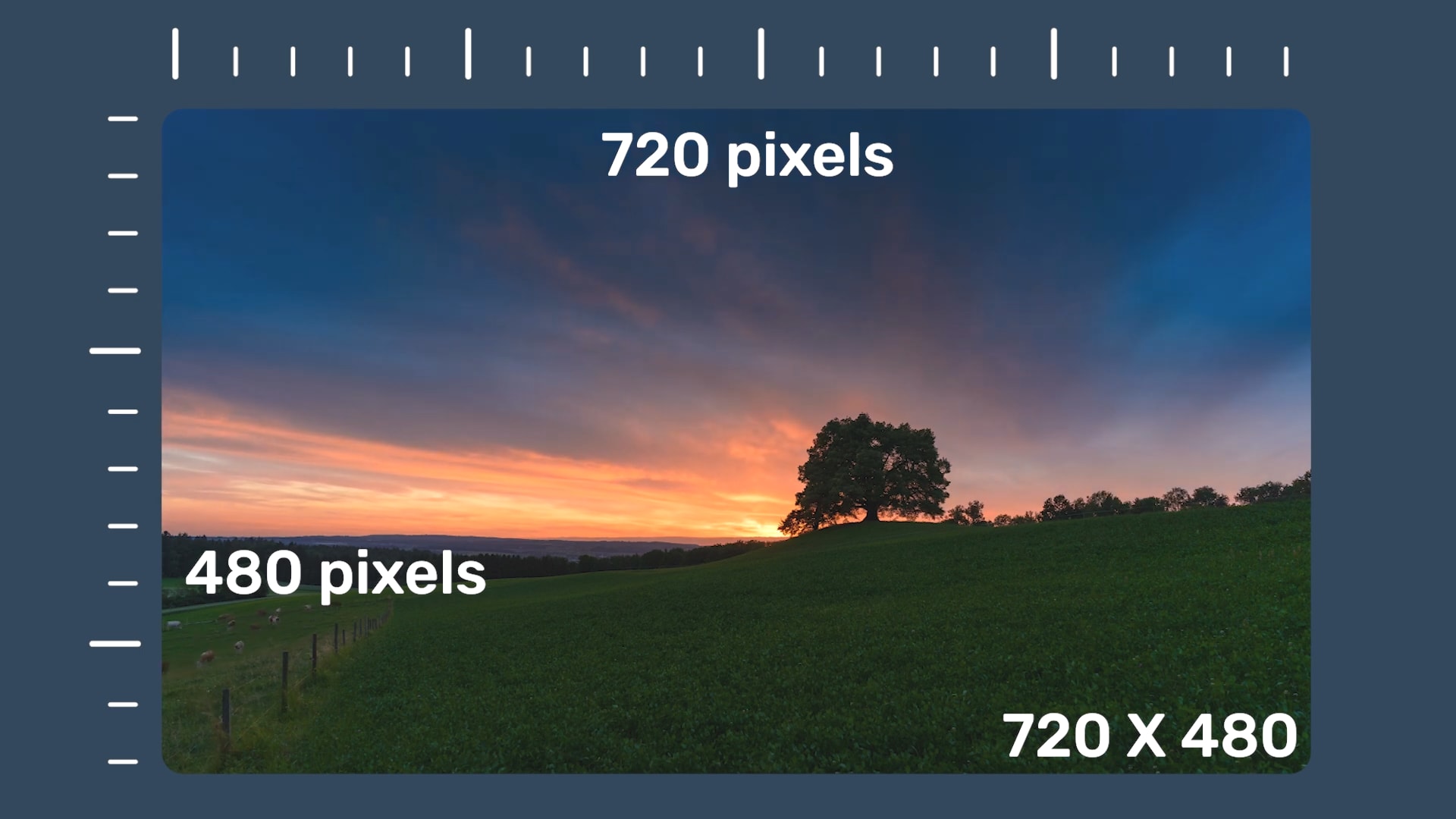
![]()
Note: The number written before is the number of horizontal pixels in a video. And the number written after is the vertical pixels in a video.
Before we adjust the resolution of a video, let’s look at a comparison between different types of video resolution.
Part 2. 7 Different Types of Video Resolution
It has been established that a video resolution is not a constant number and changes according to the screen. Scroll below to look at the different forms of video resolutions available!
360p
The full resolution is 480 x 360. This resolution is a minimal video resolution. On a big screen, 360p will look blurry. That is why a 360p resolution is the best for smaller devices such as Mobile phones.
480p
The full resolution is 853 x 480. Although an upgrade from the latter, this resolution is available on many devices. It’s mainly used in devices such as smaller TVs, laptops, and Desktop computers. It is also available for Burn-in DVDs.
720p
The full version of the resolution is 1280 x 720. This resolution is called HD, short for High Definition. 720p quality looks good almost on every device and is also reasonably available.
Most modern devices, such as Mobile phones, Touch Tablets, Laptops, and PCs, are calibrated in 720p Resolution.
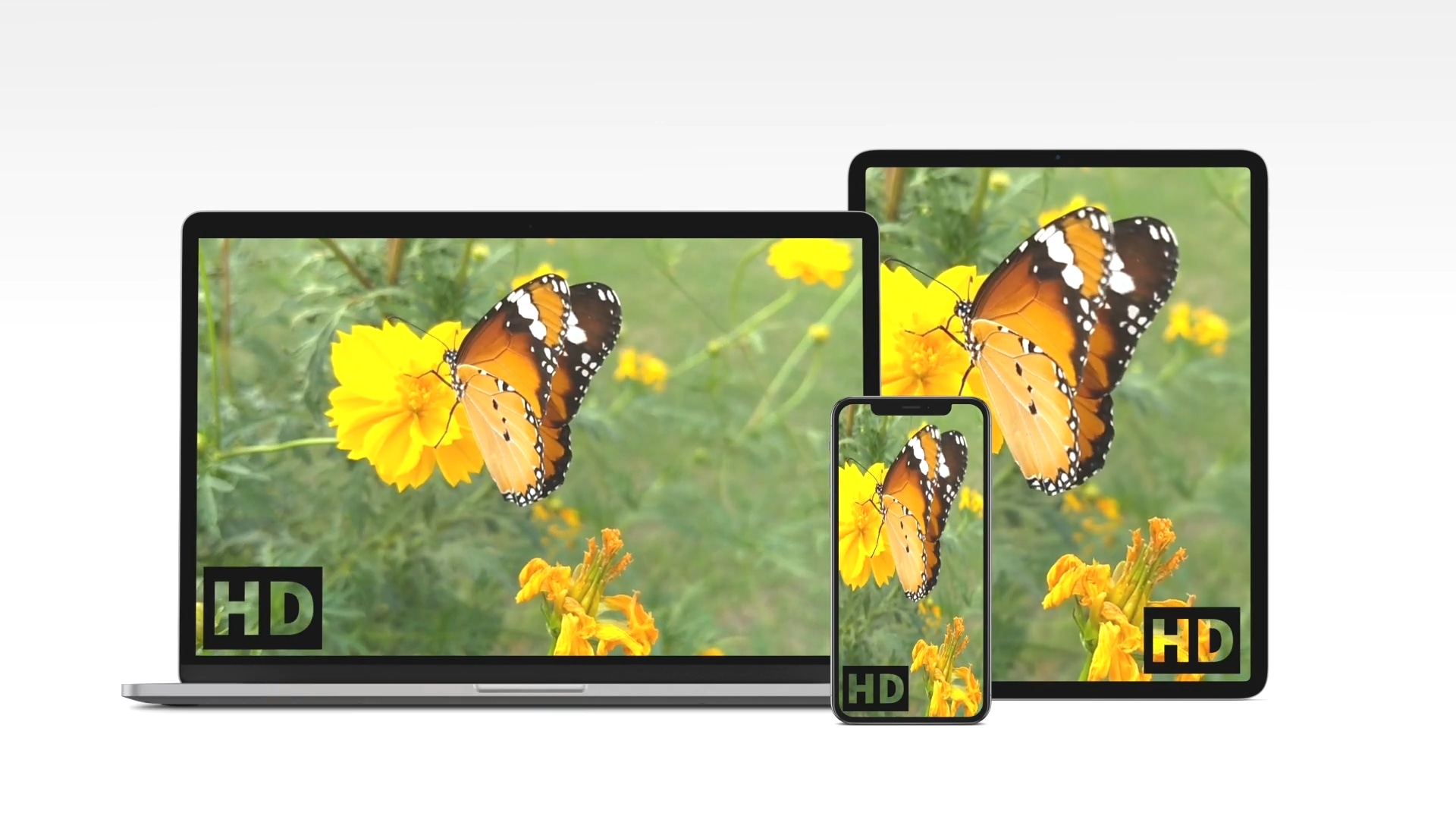
1080p
The resolution in its complete form is 1920 x 1080. This resolution is also known as FHD, short for Full High Definition. 1080p resolution is the quality in which many high-quality devices are constructed. As a result, the screens of these devices have a clear and clean display.
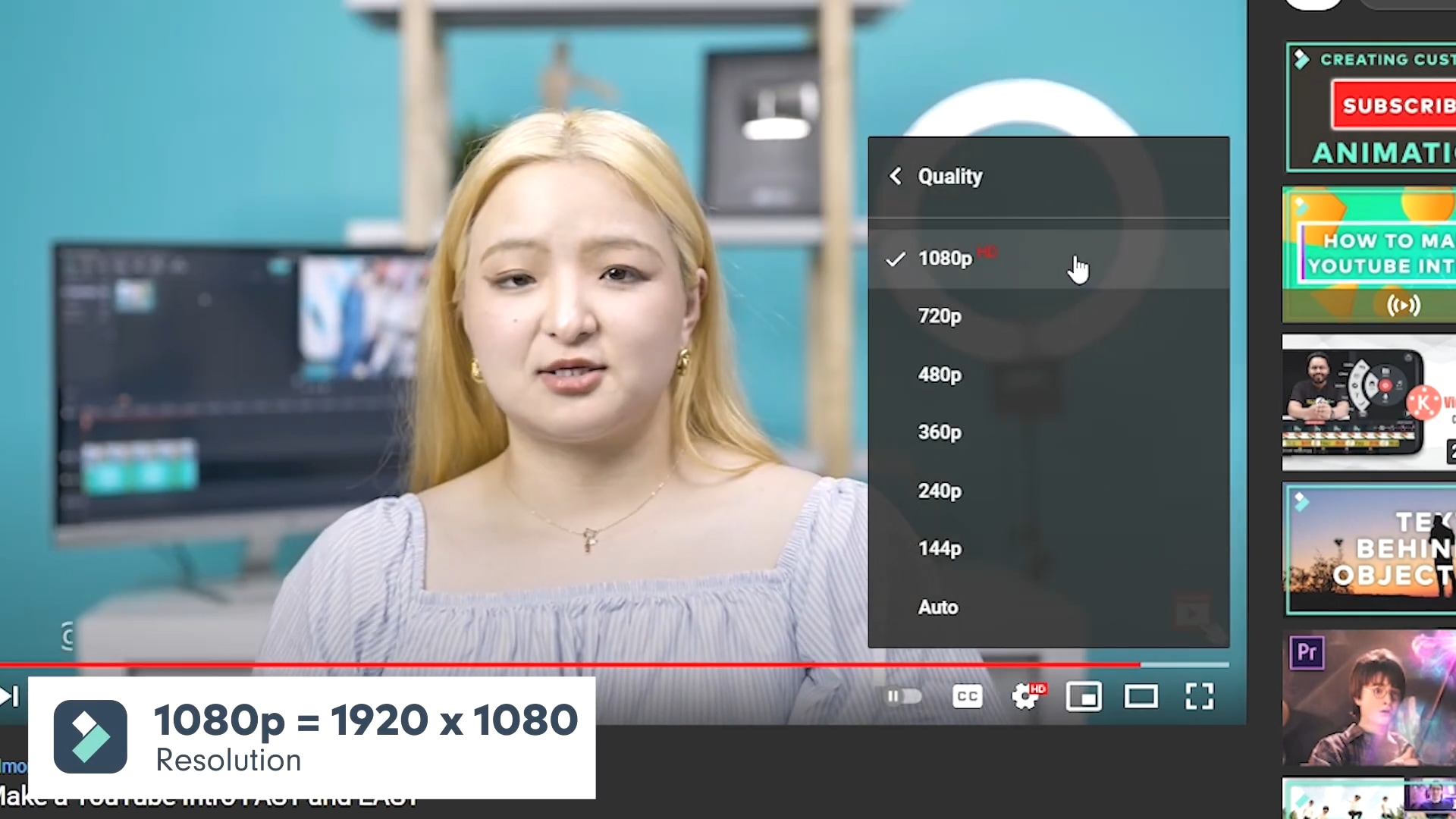
![]()
Note: It is usually recommended to share videos on social media in 1080p resolution.
1440p
This resolution is also called QHD (Quad HD). The length and width of this resolution are 2560 x 1440. As the name suggests, its quality is quad (four times) than that of a standard 720p resolution.
The screens of devices constructed in this resolution usually have a high-end purpose. For example, this resolution is commonly used in Gaming monitors and High-end smartphones.
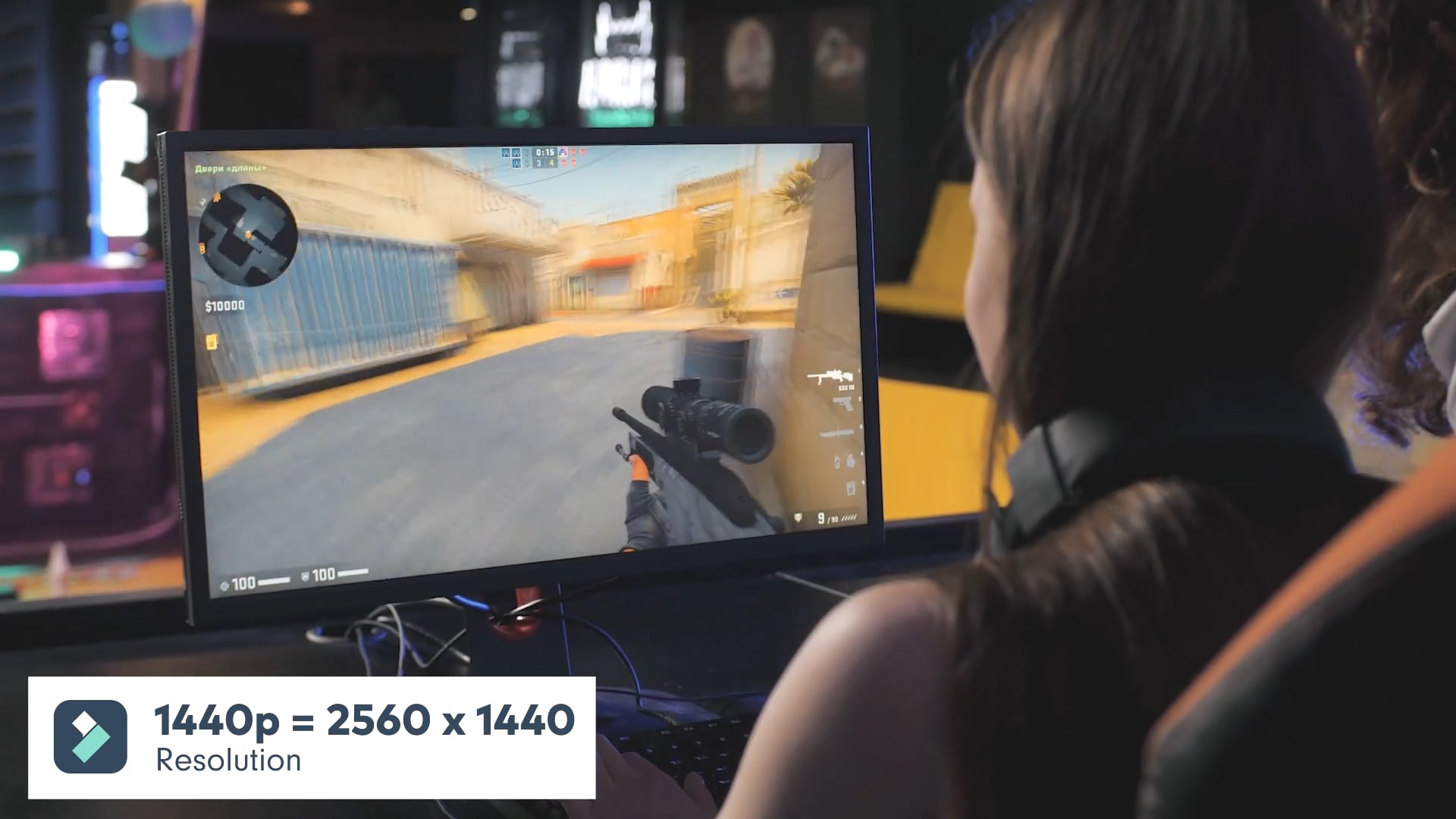
2160p
The screens constructed in this resolution are considered among the best available in the market. 2160p (3840 x 2160) is also known as UHD, which is short for Ultra High Definition. It is also known as 4K because it offers four times the power of 1080p or FHD (Full High Definition.)
These screens are usually available for high-end competitive gaming monitors or big screen LCD and LED Television. In addition, some of the flagship smartphones are also built with 4K resolution.

4320p
This resolution is also known as 8K. The length and width of the pixel arrangement are 7680 x 4320. The pixels are arranged in these screens to offer sixteen times the average power of a 1080p (FHD) monitor.
This resolution is only available on several devices, such as commercial TVs and monitors. However, this is the most significant resolution available in the modern market. Therefore, even if your monitor cannot support a larger resolution, you can test whether your PC can render an 8K resolution.
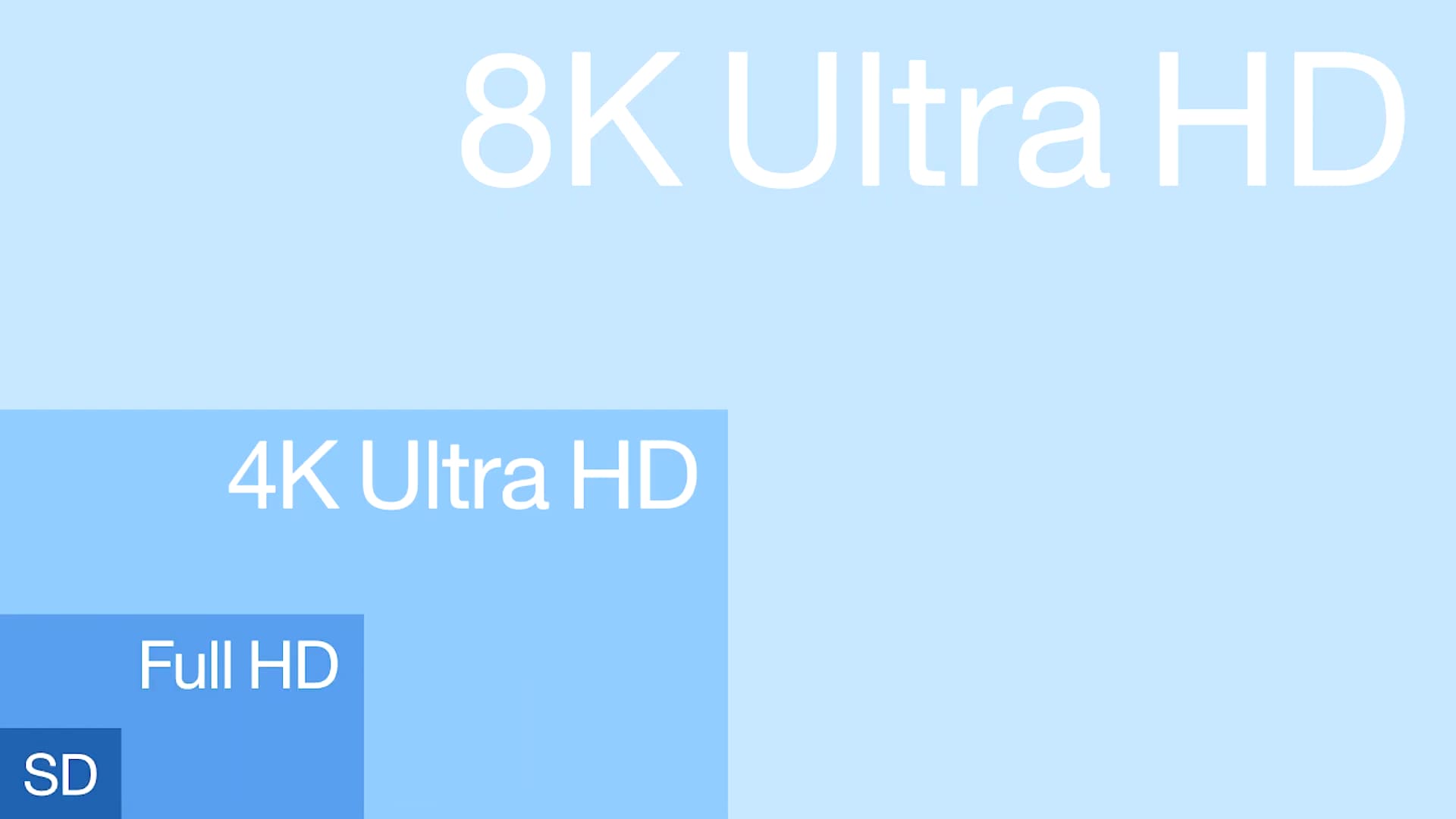
Part 3. Why Do You Need to Change a Video Resolution?
There are numerous cases where you will want to change the resolution of a video. Some of them are described below.
Decreasing a Video Resolution
Sometimes, you are trying to upload a video from a smartphone. Or, in general, you want to transfer videos to a smartphone. The resolution of your video can play a significant role in the transfer process.
If your video file has a higher resolution, it will take up more space on your phone. As well as, if your PC has a higher resolution, say a 4K resolution, and your phone is of 1080p resolution. You might not be able to play it.
To counter situations like these, you need to change the resolution of your video.
Increasing a Video Resolution
Similarly, there are instances where you would need to change the resolution of your video to increase it.
A good example would be to burn a low-quality DVD. To maintain good quality on a DVD, you need to increase its resolution before transfer.
Changing the exact resolution of a video is only possible in some cases because you cannot change the precise pixel of the video it is recorded in. But software like Wondershare Filmora allows you to change the resolution of your video easily.
Now let’s move to understanding the steps involved in changing the resolution of a video!
Part 4. Steps to Change Video Resolution in Filmora
To change the resolution of a video, you would need a basic video editor. This video editor needs to support the features that enable you to adjust a video resolution. In this case, Filmora is the best option.
Wondershare Filmora
Free Download For Win 7 or later(64-bit)
Free Download For macOS 10.14 or later
It has an attractive system UI that allows inexperienced users to learn how to use it quickly. It also has a diverse stock media collection. Not only that, but It gives you access to dependable features for changing the speed of a video.
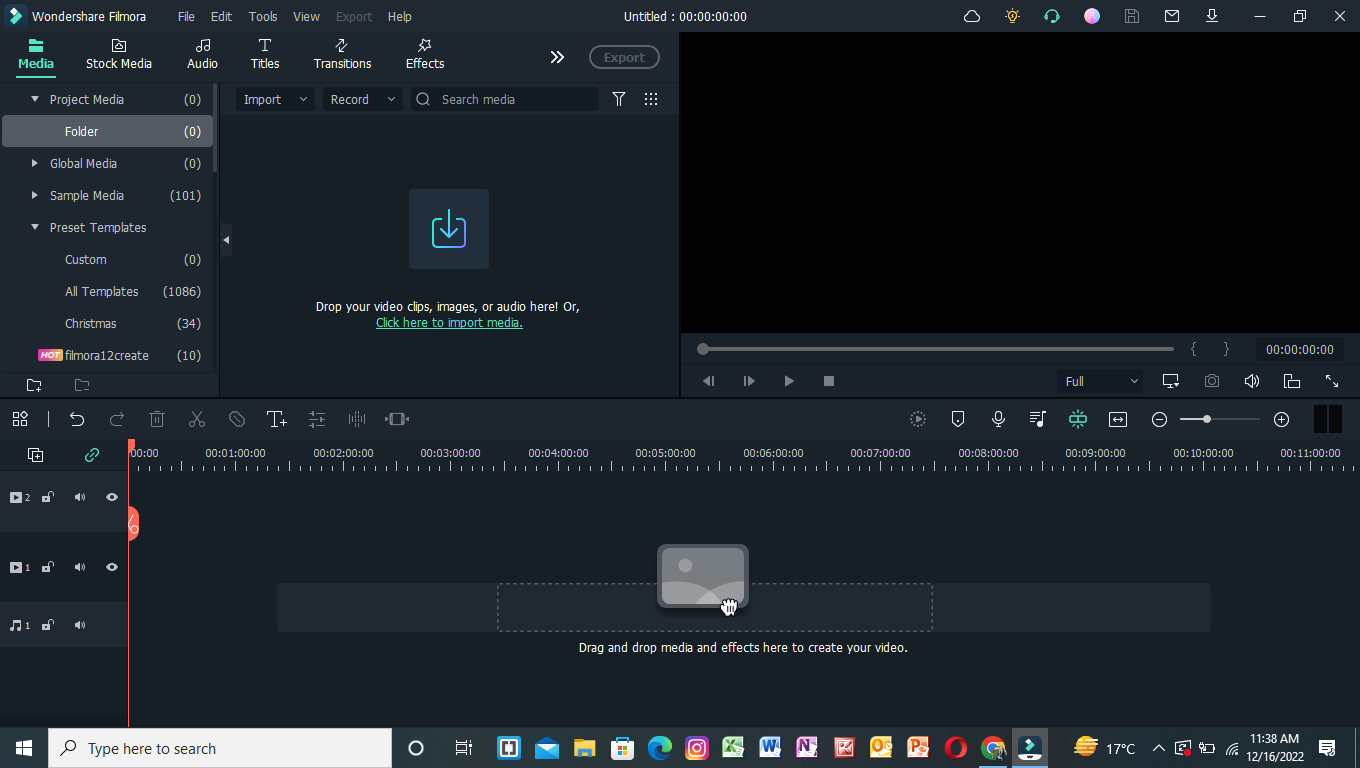
Scroll below to learn how to download the latest version!
Step1 Download Filmora
Begin by installing the latest version of Wondershare Filmora if you don’t do already. Then, run the installer of this app on your PC or Mac.
Now that you have downloaded the app let’s change the resolution!
Step2 Import Video Clips
Your next step after launching Filmora is to import video clips you want to resize. To accomplish this, follow the steps outlined below:
- Locate and select the Import icon on the top left side of the Filmora Home Interface.
- It will take you to your computer’s library.
- Select the videos to be edited and then click OK.
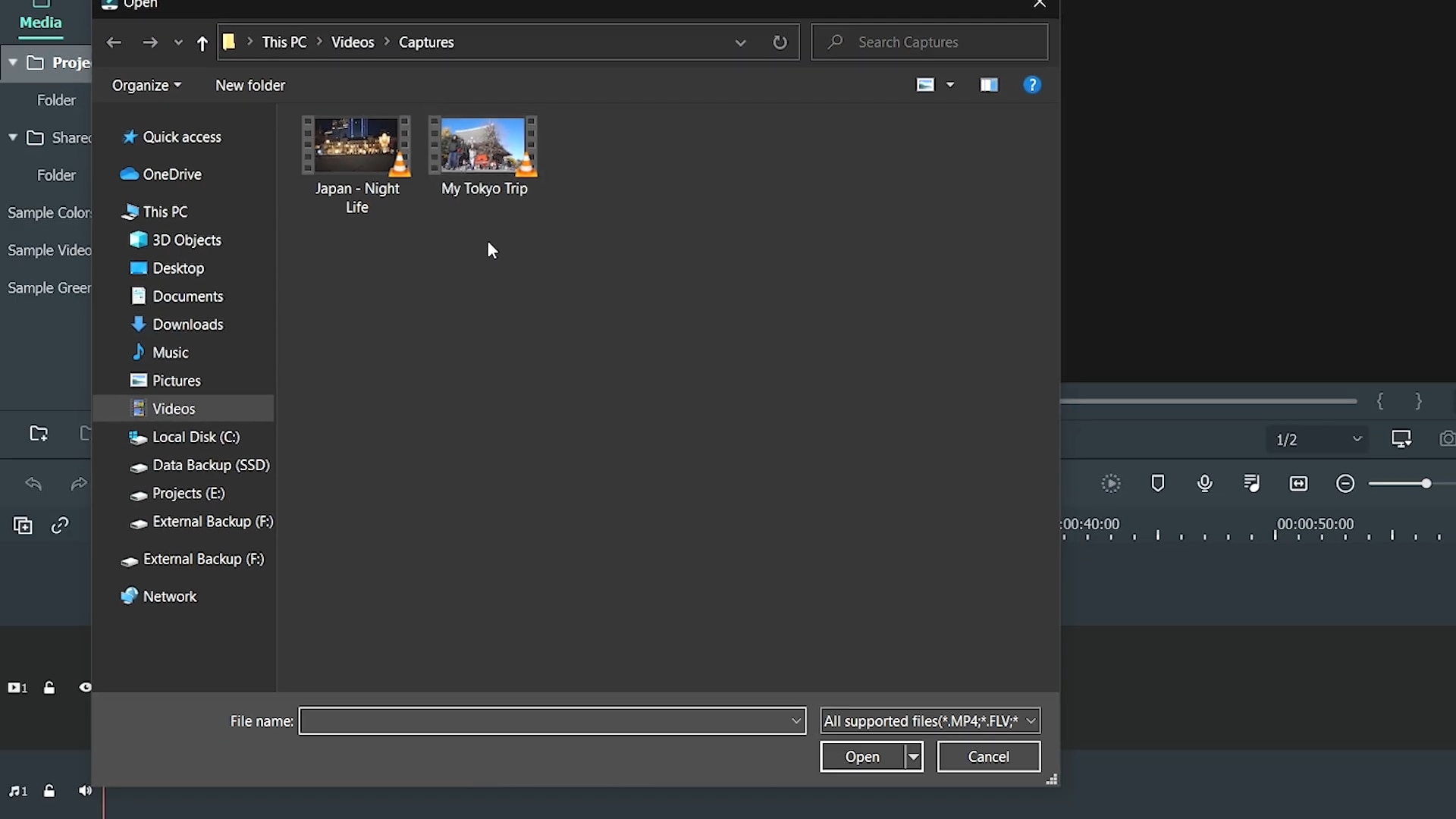
If you need clarification about the resolution of the video that you imported, you can also check them before adding it to the timeline.
- Right-Click on the video in the import window.
- In the pop-up column, go to Properties.
It opens a window that will tell you the basic info about your video clips. Here you can also preview the resolution.
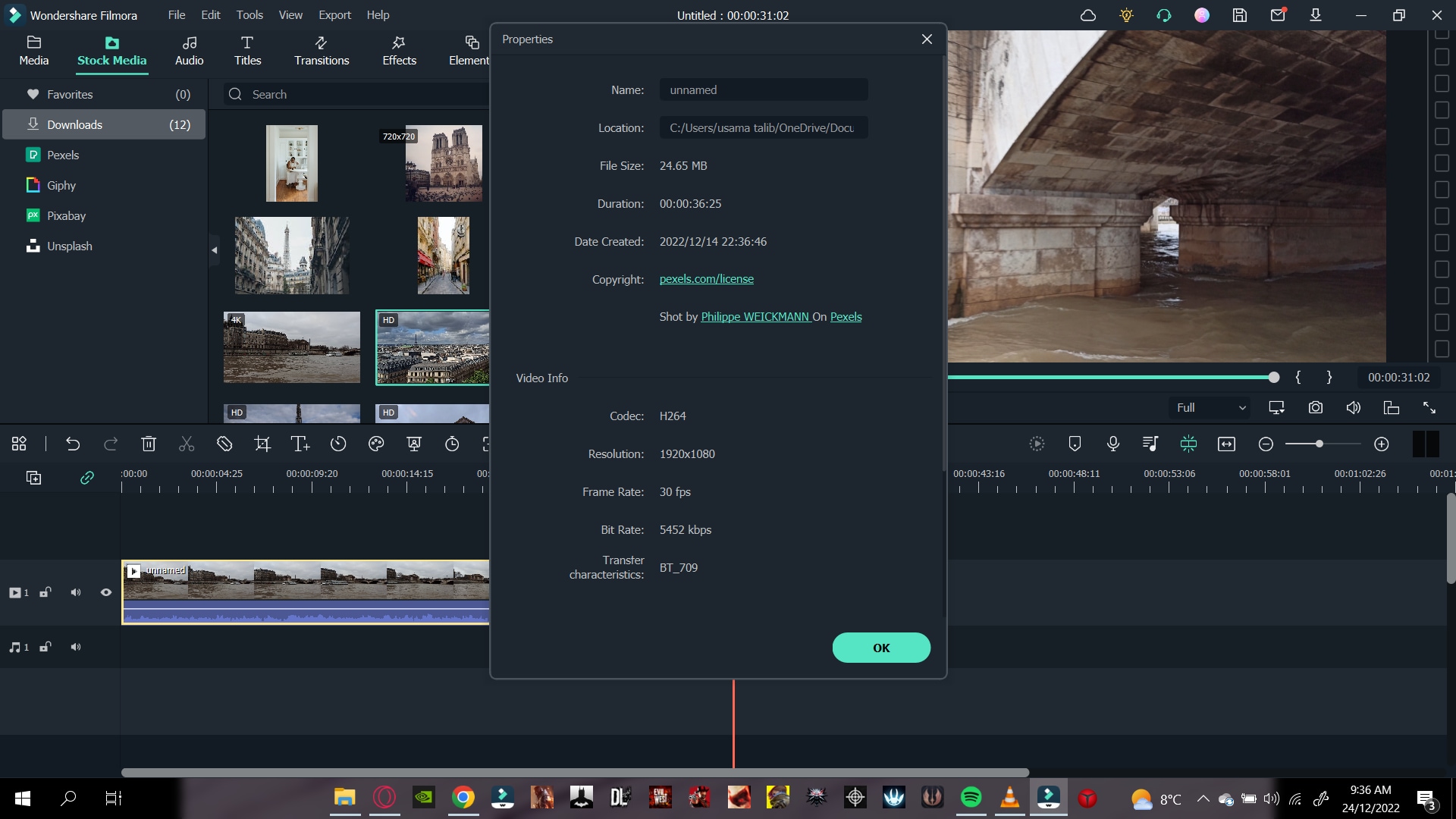
Now that we have our clips imported, it is time to add them to the timeline below!
Step3 Add The Video Clips to Timeline
To add Video clips to the timeline, go through the steps as guided:
- Hold Right click to drag and select the video clips in the import window.
- Release Right-click when in the timeline.
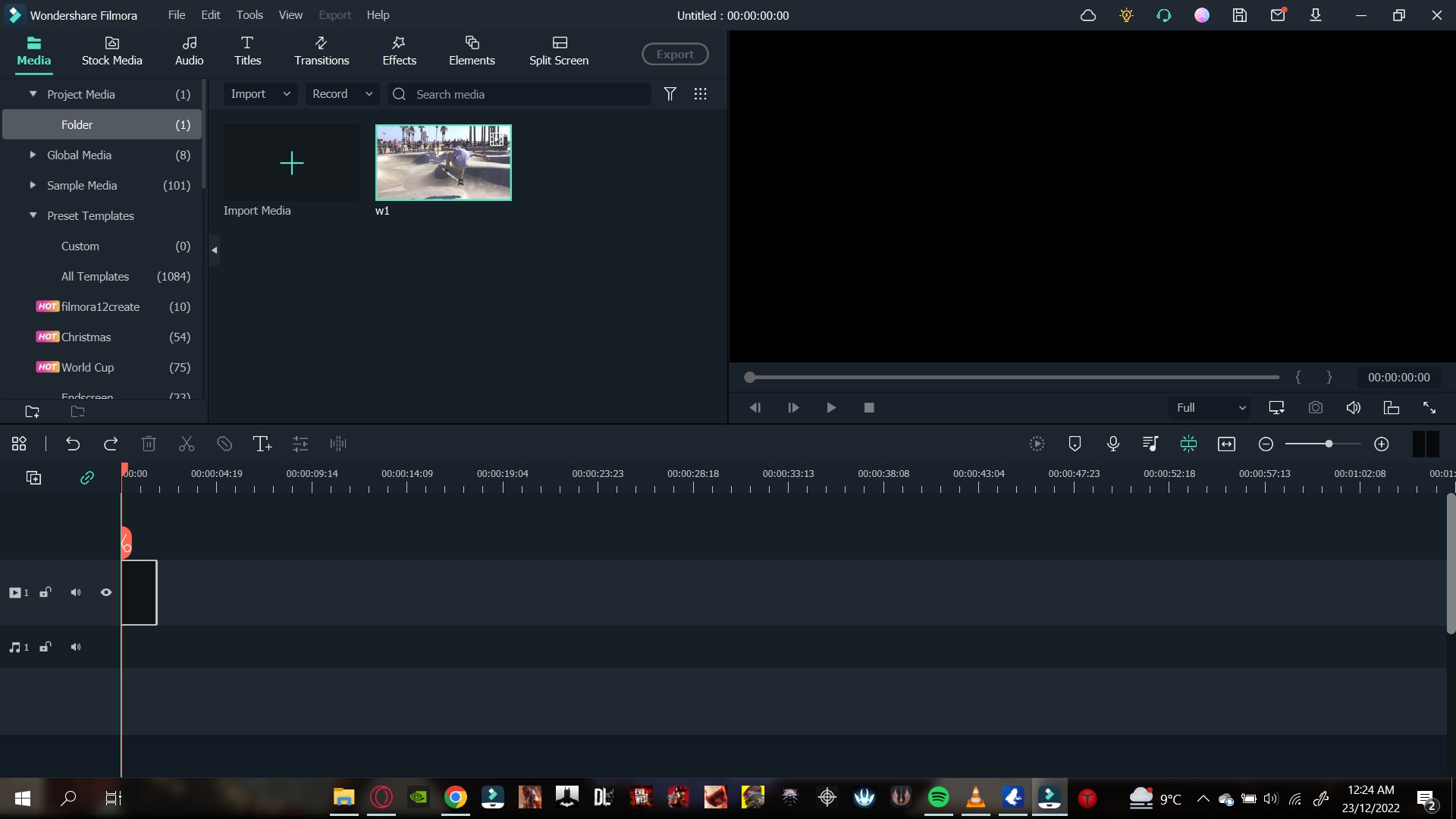
Doing so would have added the video clips to the timeline. Instead, it has created a workplace to edit our videos.
You can trim, add effects, and join multiple clips in this process. After finishing the editing process, it’s time to select an export format.
Step4 Export Your Video
You can export into video formats in two ways with Filmora. It can be either selecting a format for your video. Or you can also choose to export your video to a particular device.
Video Format Resolution
Wondershare Filmora is a fantastic software that allows you to access a variety of formats for your videos. These export formats include MP4, WMV, F4V, MOV, TS, 3GP, and more. To select a format for your video, follow the steps as guided:
- Click on Export.
- In the left column, click on the video format you need.
- Click Export on the bottom right corner of the window.
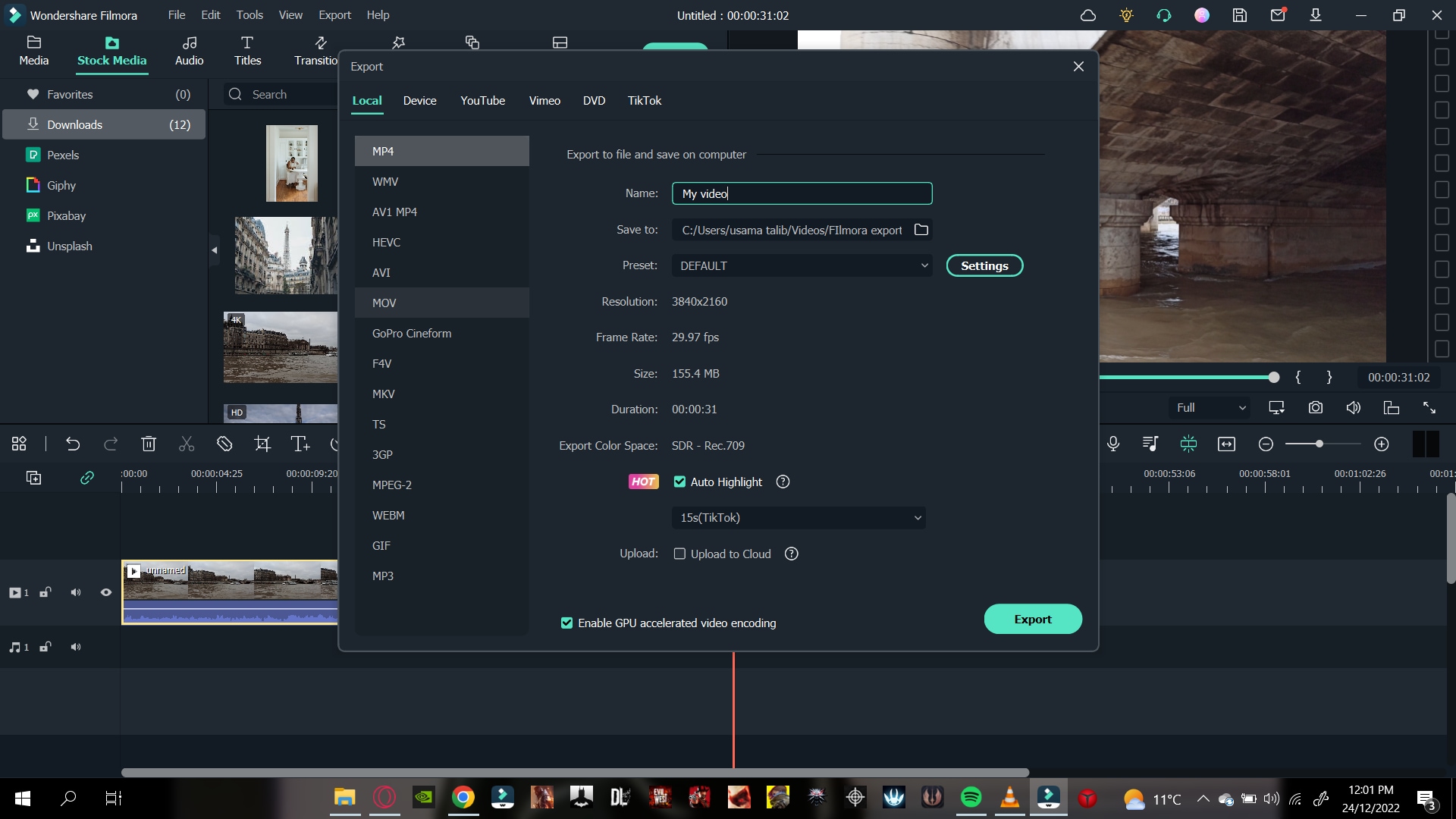
Exporting a video in a specific format not only allows you to change the format of a video but also allows you to change the resolution simultaneously.
Default Resolution Settings
Some formats have a built-in resolution. Whenever you choose a specific format for a video, the resolution of the video will be shifted to the resolution of that format, i.e., TS has a default 1080p resolution.
![]()
Note: Another thing to remember is that most video formats have defaulted to 1080p. But there are some formats whose resolutions vary according to their style. A good example is a 3GP format, which is set to 352 x 488 by default.
Customize the Resolution
But if you don’t find the resolution stable for your device, you can also change this default resolution in simple steps. In the export window, follow the steps mentioned ahead:
- In the preset tab, go to > settings.
- In the video tab, click on the resolution.
- In the drop-down menu, select the resolution that you desire.
You can also select a custom resolution by these steps:
- In the drop-down menu, click on Custom.
- Here, you can change the height and width according to your wish.
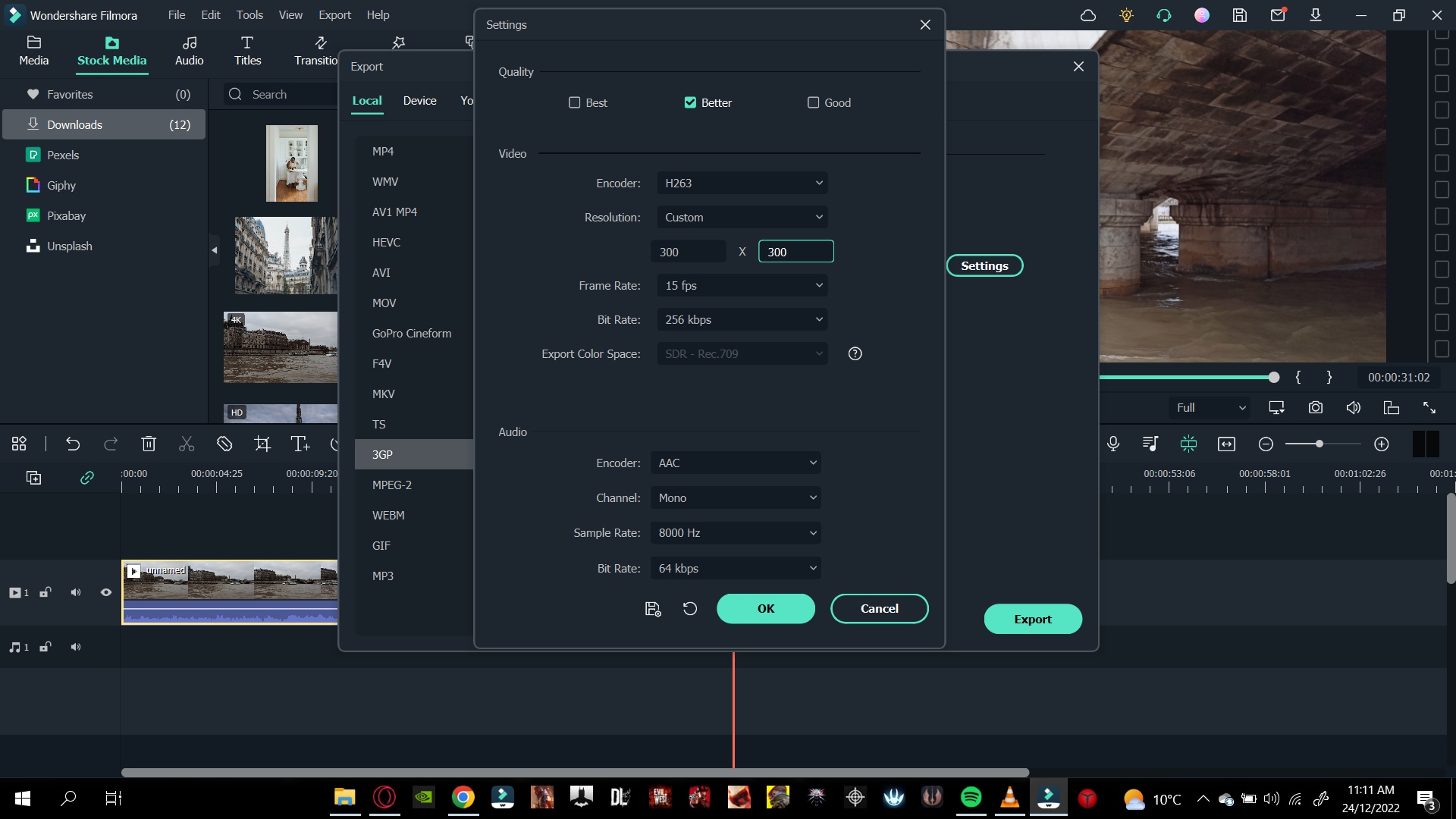
Exporting a Video to a Specific Device
Selecting a format for your video can help if you want to change the resolution. But in cases where you want to export a video to a particular mobile device. Such as an iPhone or an iPad, you can select the device export option.
In the device export option, you can select a custom device. Filmora allows you to choose from a wide variety of machines available when you choose a custom device; the resolution will be set to optimal for that particular device.
Select a Folder to Export Your Video
After you are done calibrating the resolution settings, you can move on to select the export location for your video. You can do so by the steps mentioned:
- In the main Export window, navigate to the Save
- Click on the Folder
- It will direct you to your PC library.
- Select the directory you want to export your video to.
- Click Select Folder.
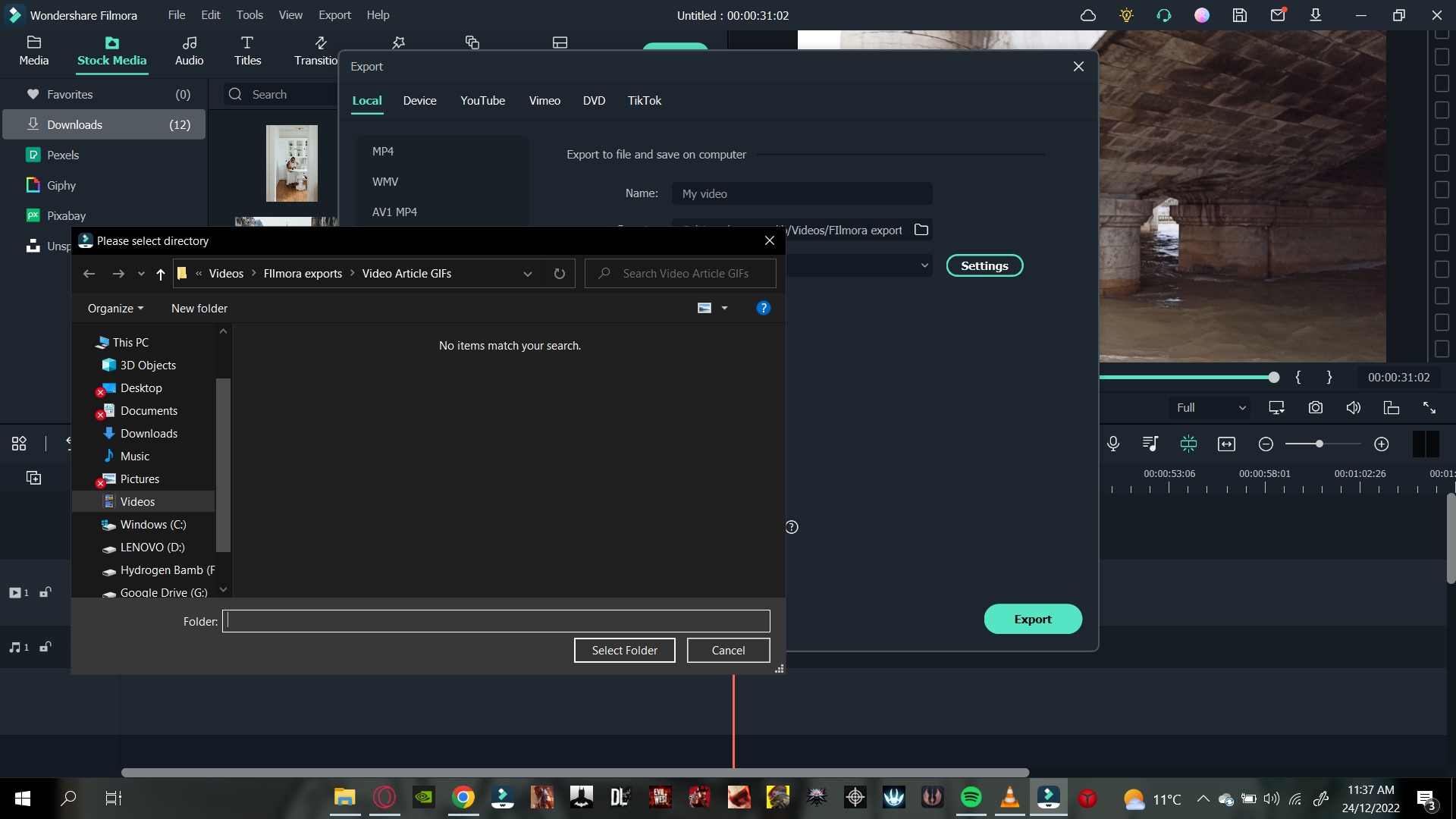
Final Step
The last step to export your video is clicking on the Export icon in the bottom right corner of the window. It opens up a render window. Wait for a few minutes until the video finishes exporting.
When the export is finished, a window will pop up as a reminder. You can also find the target folder by clicking on Find Target.
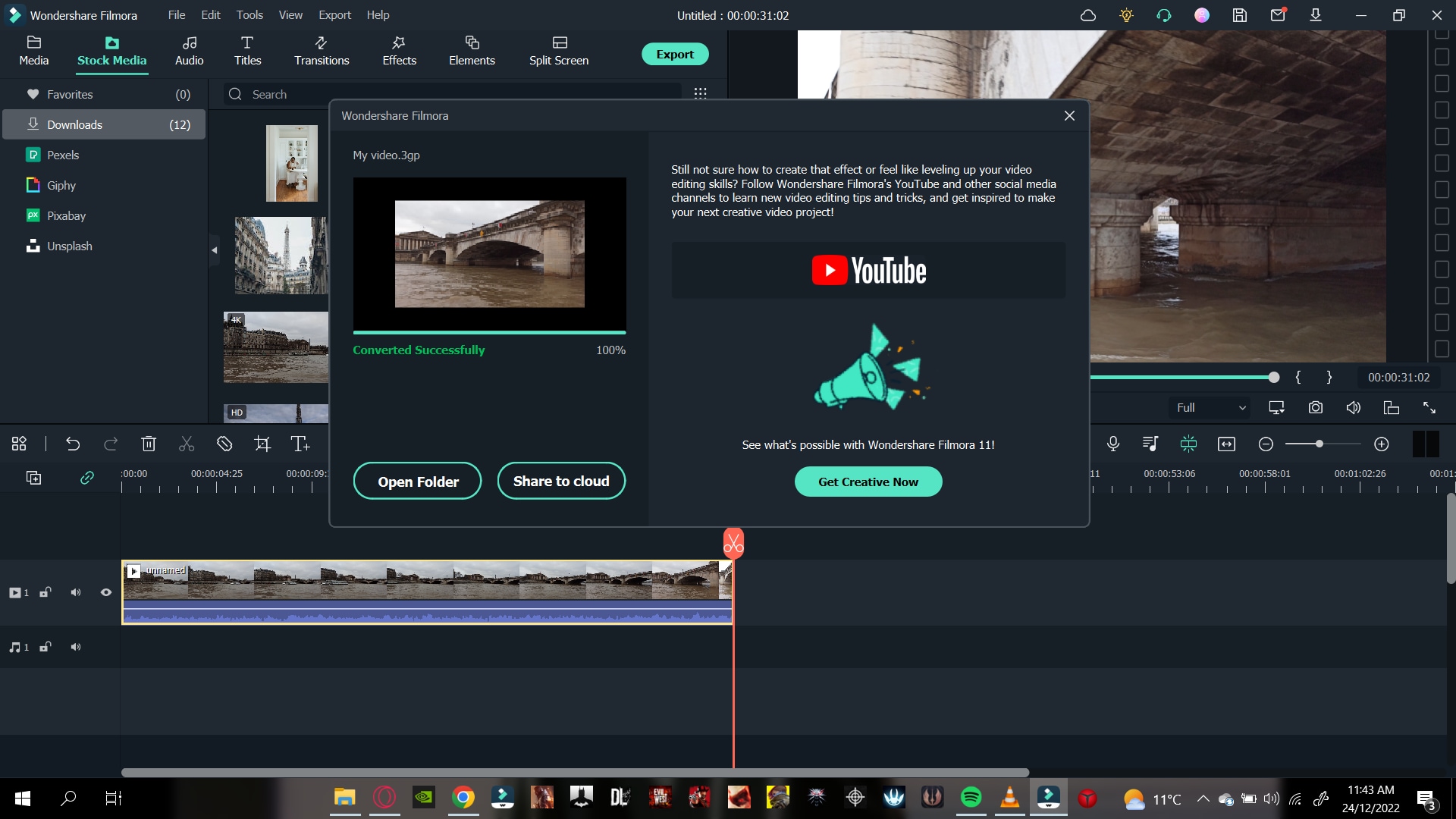
Congratulations! You have successfully learned how to change the resolution of a video using Wondershare Filmora.
Conclusion
Rapid video technology advancement is leading to the development of higher-resolution devices. The greatest resolution in the modern day is the 8K; soon, everyone will be using 8K devices. So, it is beneficial to learn how to change a video’s resolution.
By following the steps mentioned in this article, you can now change the resolution of your video using Filmora.
Before we adjust the resolution of a video, let’s look at a comparison between different types of video resolution.
Part 2. 7 Different Types of Video Resolution
It has been established that a video resolution is not a constant number and changes according to the screen. Scroll below to look at the different forms of video resolutions available!
360p
The full resolution is 480 x 360. This resolution is a minimal video resolution. On a big screen, 360p will look blurry. That is why a 360p resolution is the best for smaller devices such as Mobile phones.
480p
The full resolution is 853 x 480. Although an upgrade from the latter, this resolution is available on many devices. It’s mainly used in devices such as smaller TVs, laptops, and Desktop computers. It is also available for Burn-in DVDs.
720p
The full version of the resolution is 1280 x 720. This resolution is called HD, short for High Definition. 720p quality looks good almost on every device and is also reasonably available.
Most modern devices, such as Mobile phones, Touch Tablets, Laptops, and PCs, are calibrated in 720p Resolution.

1080p
The resolution in its complete form is 1920 x 1080. This resolution is also known as FHD, short for Full High Definition. 1080p resolution is the quality in which many high-quality devices are constructed. As a result, the screens of these devices have a clear and clean display.

![]()
Note: It is usually recommended to share videos on social media in 1080p resolution.
1440p
This resolution is also called QHD (Quad HD). The length and width of this resolution are 2560 x 1440. As the name suggests, its quality is quad (four times) than that of a standard 720p resolution.
The screens of devices constructed in this resolution usually have a high-end purpose. For example, this resolution is commonly used in Gaming monitors and High-end smartphones.

2160p
The screens constructed in this resolution are considered among the best available in the market. 2160p (3840 x 2160) is also known as UHD, which is short for Ultra High Definition. It is also known as 4K because it offers four times the power of 1080p or FHD (Full High Definition.)
These screens are usually available for high-end competitive gaming monitors or big screen LCD and LED Television. In addition, some of the flagship smartphones are also built with 4K resolution.

4320p
This resolution is also known as 8K. The length and width of the pixel arrangement are 7680 x 4320. The pixels are arranged in these screens to offer sixteen times the average power of a 1080p (FHD) monitor.
This resolution is only available on several devices, such as commercial TVs and monitors. However, this is the most significant resolution available in the modern market. Therefore, even if your monitor cannot support a larger resolution, you can test whether your PC can render an 8K resolution.

Part 3. Why Do You Need to Change a Video Resolution?
There are numerous cases where you will want to change the resolution of a video. Some of them are described below.
Decreasing a Video Resolution
Sometimes, you are trying to upload a video from a smartphone. Or, in general, you want to transfer videos to a smartphone. The resolution of your video can play a significant role in the transfer process.
If your video file has a higher resolution, it will take up more space on your phone. As well as, if your PC has a higher resolution, say a 4K resolution, and your phone is of 1080p resolution. You might not be able to play it.
To counter situations like these, you need to change the resolution of your video.
Increasing a Video Resolution
Similarly, there are instances where you would need to change the resolution of your video to increase it.
A good example would be to burn a low-quality DVD. To maintain good quality on a DVD, you need to increase its resolution before transfer.
Changing the exact resolution of a video is only possible in some cases because you cannot change the precise pixel of the video it is recorded in. But software like Wondershare Filmora allows you to change the resolution of your video easily.
Now let’s move to understanding the steps involved in changing the resolution of a video!
Part 4. Steps to Change Video Resolution in Filmora
To change the resolution of a video, you would need a basic video editor. This video editor needs to support the features that enable you to adjust a video resolution. In this case, Filmora is the best option.
Wondershare Filmora
Free Download For Win 7 or later(64-bit)
Free Download For macOS 10.14 or later
It has an attractive system UI that allows inexperienced users to learn how to use it quickly. It also has a diverse stock media collection. Not only that, but It gives you access to dependable features for changing the speed of a video.

Scroll below to learn how to download the latest version!
Step1 Download Filmora
Begin by installing the latest version of Wondershare Filmora if you don’t do already. Then, run the installer of this app on your PC or Mac.
Now that you have downloaded the app let’s change the resolution!
Step2 Import Video Clips
Your next step after launching Filmora is to import video clips you want to resize. To accomplish this, follow the steps outlined below:
- Locate and select the Import icon on the top left side of the Filmora Home Interface.
- It will take you to your computer’s library.
- Select the videos to be edited and then click OK.

If you need clarification about the resolution of the video that you imported, you can also check them before adding it to the timeline.
- Right-Click on the video in the import window.
- In the pop-up column, go to Properties.
It opens a window that will tell you the basic info about your video clips. Here you can also preview the resolution.

Now that we have our clips imported, it is time to add them to the timeline below!
Step3 Add The Video Clips to Timeline
To add Video clips to the timeline, go through the steps as guided:
- Hold Right click to drag and select the video clips in the import window.
- Release Right-click when in the timeline.

Doing so would have added the video clips to the timeline. Instead, it has created a workplace to edit our videos.
You can trim, add effects, and join multiple clips in this process. After finishing the editing process, it’s time to select an export format.
Step4 Export Your Video
You can export into video formats in two ways with Filmora. It can be either selecting a format for your video. Or you can also choose to export your video to a particular device.
Video Format Resolution
Wondershare Filmora is a fantastic software that allows you to access a variety of formats for your videos. These export formats include MP4, WMV, F4V, MOV, TS, 3GP, and more. To select a format for your video, follow the steps as guided:
- Click on Export.
- In the left column, click on the video format you need.
- Click Export on the bottom right corner of the window.

Exporting a video in a specific format not only allows you to change the format of a video but also allows you to change the resolution simultaneously.
Default Resolution Settings
Some formats have a built-in resolution. Whenever you choose a specific format for a video, the resolution of the video will be shifted to the resolution of that format, i.e., TS has a default 1080p resolution.
![]()
Note: Another thing to remember is that most video formats have defaulted to 1080p. But there are some formats whose resolutions vary according to their style. A good example is a 3GP format, which is set to 352 x 488 by default.
Customize the Resolution
But if you don’t find the resolution stable for your device, you can also change this default resolution in simple steps. In the export window, follow the steps mentioned ahead:
- In the preset tab, go to > settings.
- In the video tab, click on the resolution.
- In the drop-down menu, select the resolution that you desire.
You can also select a custom resolution by these steps:
- In the drop-down menu, click on Custom.
- Here, you can change the height and width according to your wish.

Exporting a Video to a Specific Device
Selecting a format for your video can help if you want to change the resolution. But in cases where you want to export a video to a particular mobile device. Such as an iPhone or an iPad, you can select the device export option.
In the device export option, you can select a custom device. Filmora allows you to choose from a wide variety of machines available when you choose a custom device; the resolution will be set to optimal for that particular device.
Select a Folder to Export Your Video
After you are done calibrating the resolution settings, you can move on to select the export location for your video. You can do so by the steps mentioned:
- In the main Export window, navigate to the Save
- Click on the Folder
- It will direct you to your PC library.
- Select the directory you want to export your video to.
- Click Select Folder.

Final Step
The last step to export your video is clicking on the Export icon in the bottom right corner of the window. It opens up a render window. Wait for a few minutes until the video finishes exporting.
When the export is finished, a window will pop up as a reminder. You can also find the target folder by clicking on Find Target.

Congratulations! You have successfully learned how to change the resolution of a video using Wondershare Filmora.
Conclusion
Rapid video technology advancement is leading to the development of higher-resolution devices. The greatest resolution in the modern day is the 8K; soon, everyone will be using 8K devices. So, it is beneficial to learn how to change a video’s resolution.
By following the steps mentioned in this article, you can now change the resolution of your video using Filmora.
Also read:
- New In 2024, Merge MP4 Online? Its Easy With These 5 Tools
- New 2024 Approved Replacing the Sky in Adobe After Effects An Extensive Guide
- New Top 6 Best Alternatives to Clownfish Voice Changer
- Updated In 2024, How Long Does It Take To Edit Videos
- Updated In 2024, How to Brighten Video in Premiere Pro
- 2024 Approved This Article Describes Different Ways for Removing Gif Backgrounds, How We Can Use Them, and How This Way Differs From One Another
- New How to Create Chroma Key Written Text Effects in Filmora
- New 2024 Approved How to Loop Video in Canva
- Updated Color Finale Is a Color Grading Plugin for Final Cur Pro. It Allows Users to Make Cinematic Looking Video Scenes by Adjusting the Color. Here Well Share You some Basic Information About This Plugin
- How to Loop a Video on Android for 2024
- Are You Planning to Make a Product Review Video but Wondering How to Set up Your Background? If so, Then Youre in the Right Place. This Post Will Show You How to Adjust the Background to Black for Your Product Review Video
- How to Get Motion Blur in Roblox, In 2024
- GIF Splitting Into Frames Is an Interesting Activity to Do with the Right Tools. Convert GIFs Into Frames Easily with Tools and Use Them as Needed
- How to Do Masking in After Effects Alternative Provided for 2024
- 2024 Approved How to Create a Slideshow with Icecream Slideshow Maker
- 2024 Approved Now, You Can Also Apply the Stranger Things Upside Down Effect to Your Video! This Effect Combines Camera Tricks and Video Editing Within Filmora to Transition From the Normal World Into the Upside Down
- How to Intercept Text Messages on Samsung Galaxy M14 5G | Dr.fone
- Top 11 Free Apps to Check IMEI on Nokia C110 Phones
- How Do I SIM Unlock My Apple iPhone 12 Pro Max?
- How to Transfer Videos from Realme Narzo 60 5G to iPad | Dr.fone
- In 2024, How to Transfer Data After Switching From Lava Blaze Curve 5G to Latest Samsung | Dr.fone
- Apple ID is Greyed Out From iPhone 14 Pro How to Bypass?
- How to Enable, Disable, and Change Safari Location on Apple iPhone 13 | Dr.fone
- Gmail Not Working on Xiaomi Civi 3 7 Common Problems & Fixes | Dr.fone
- iPhone 15 Plus Backup Password Never Set But Still Asking? Heres the Fix
- How to recover deleted contacts from OnePlus .
- 5 Easy Ways to Change Location on YouTube TV On Oppo A78 5G | Dr.fone
- In 2024, How To Unlock Apple iPhone 7 Plus Without Passcode? 4 Easy Methods | Dr.fone
- Issues playing MOV videos on Samsung Galaxy XCover 6 Pro Tactical Edition
- In 2024, What Is a SIM Network Unlock PIN? Get Your Motorola Moto G Stylus (2023) Phone Network-Ready
- In 2024, All You Need To Know About Mega Greninja For Tecno Camon 20 | Dr.fone
- Title: 2024 Approved Repeated Text Animation Tutorial
- Author: Chloe
- Created at : 2024-06-26 06:24:14
- Updated at : 2024-06-27 06:24:14
- Link: https://ai-editing-video.techidaily.com/2024-approved-repeated-text-animation-tutorial/
- License: This work is licensed under CC BY-NC-SA 4.0.


